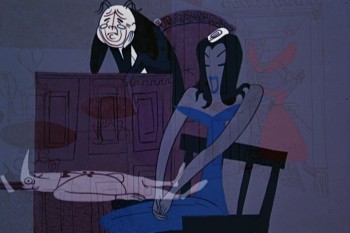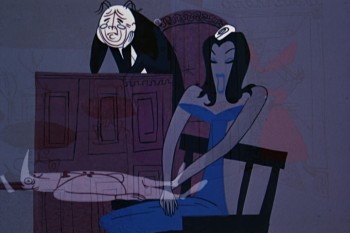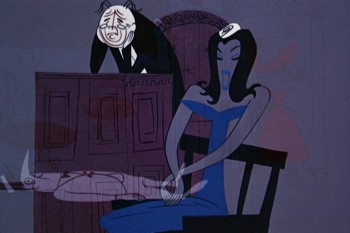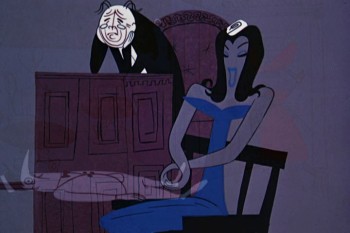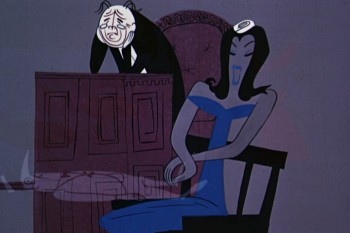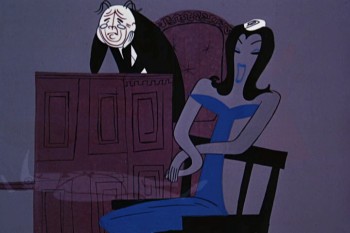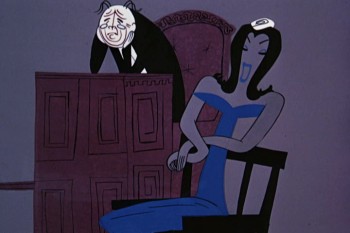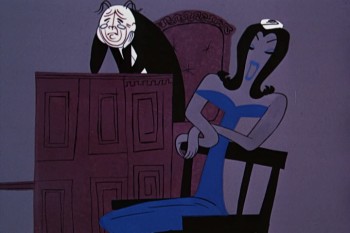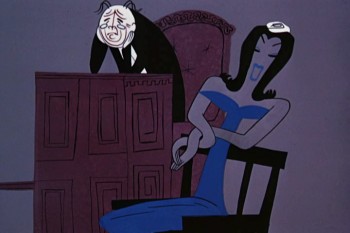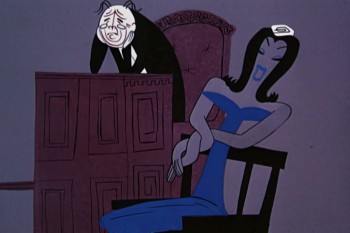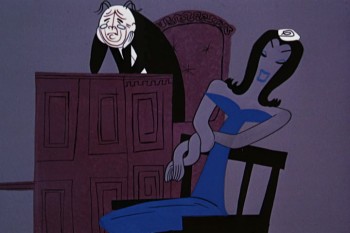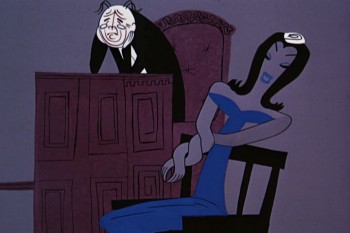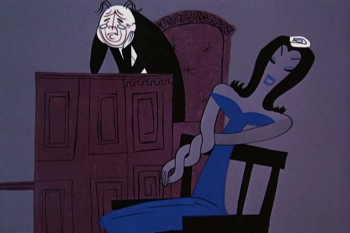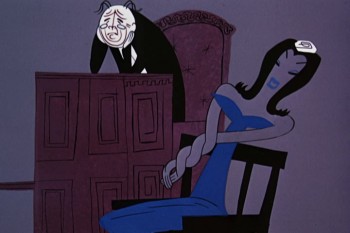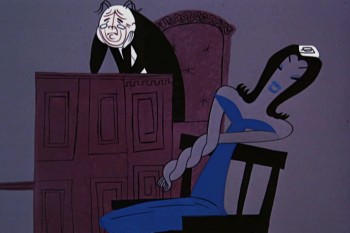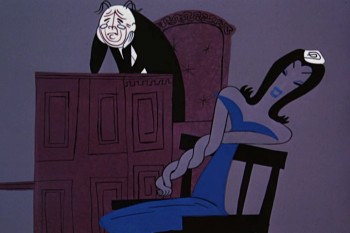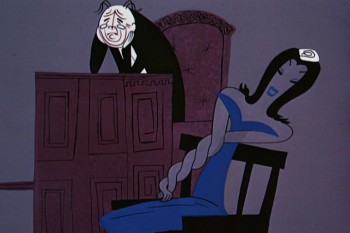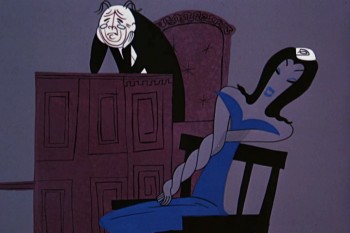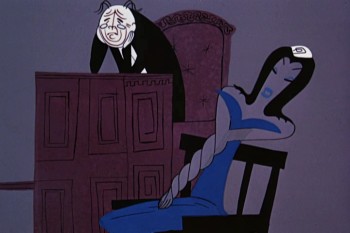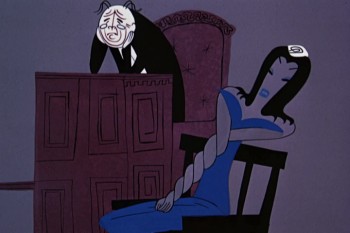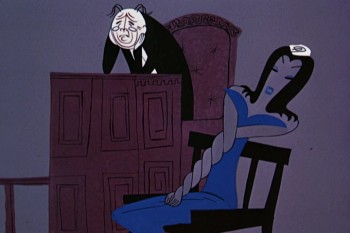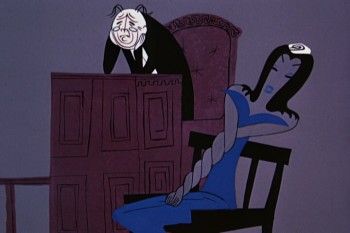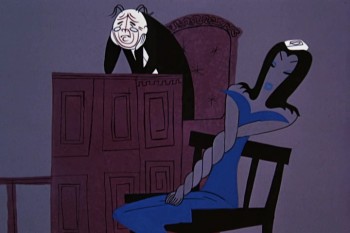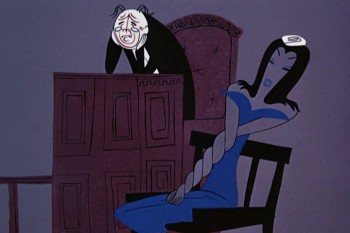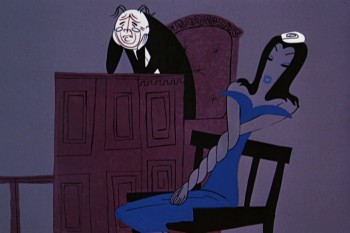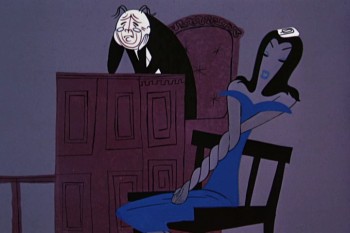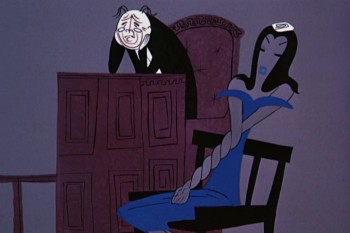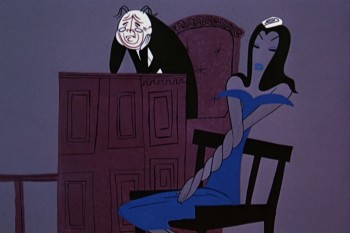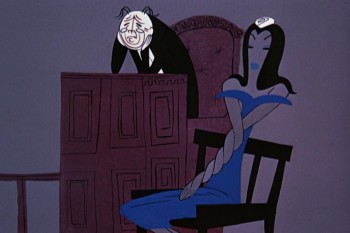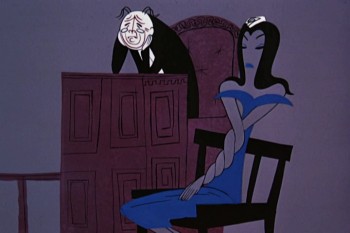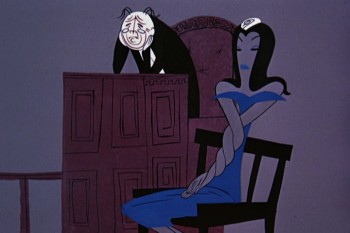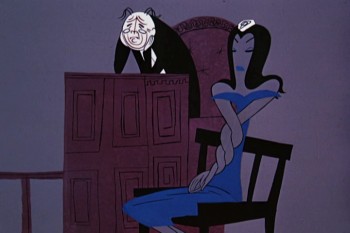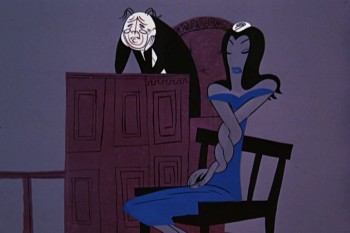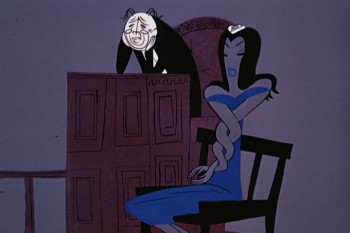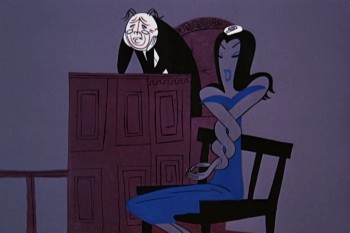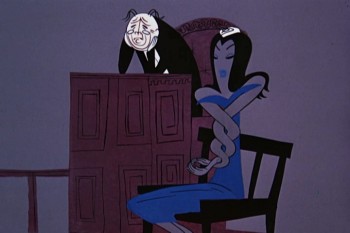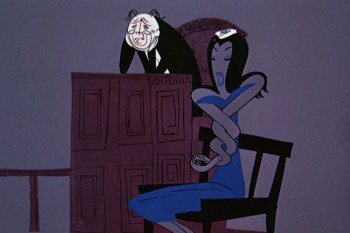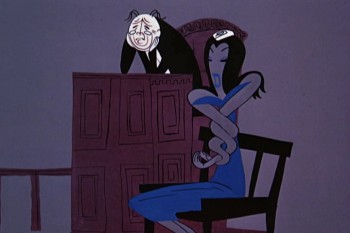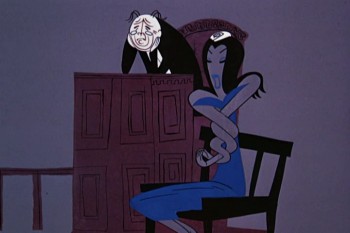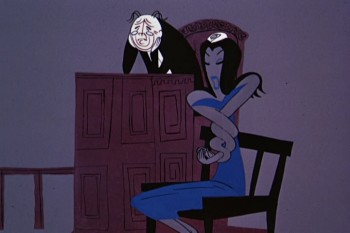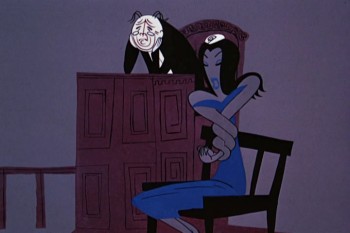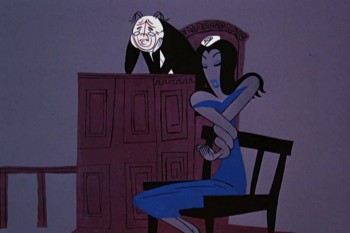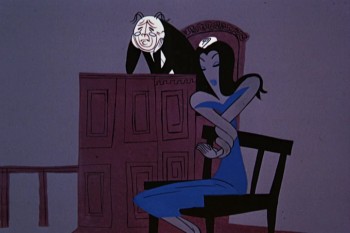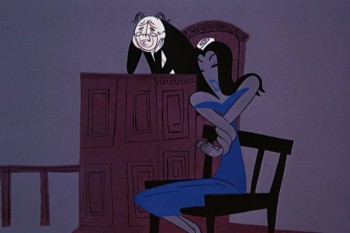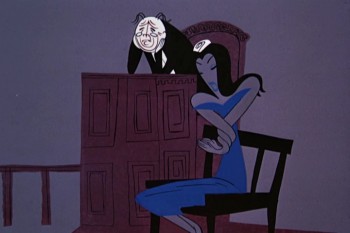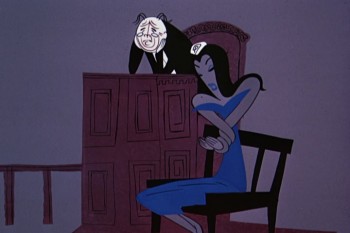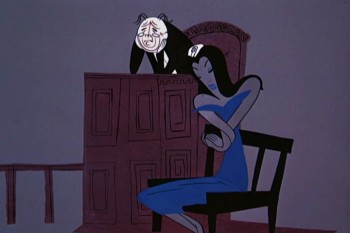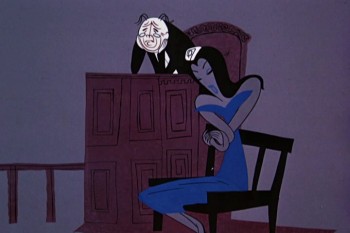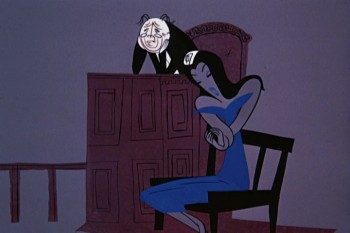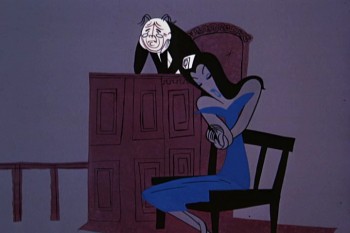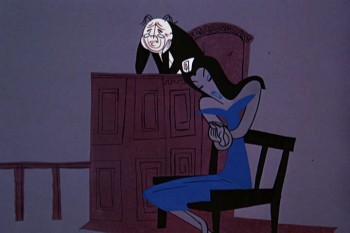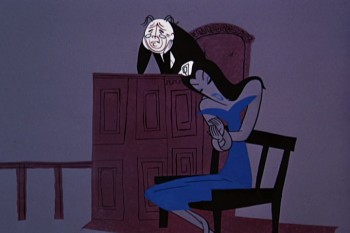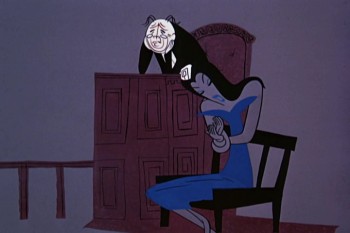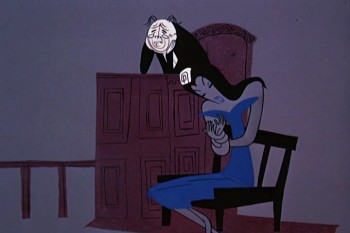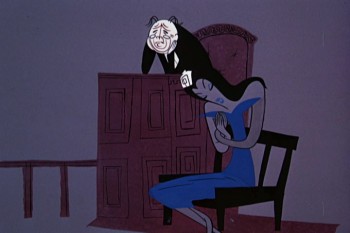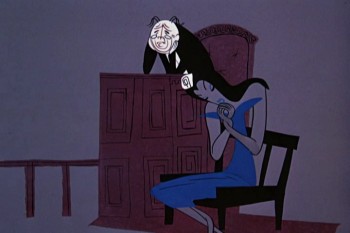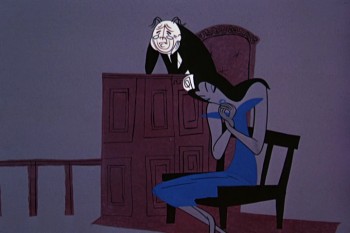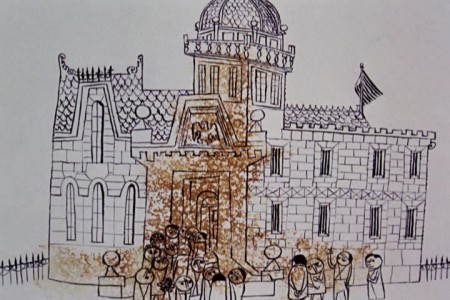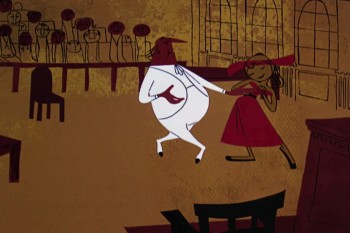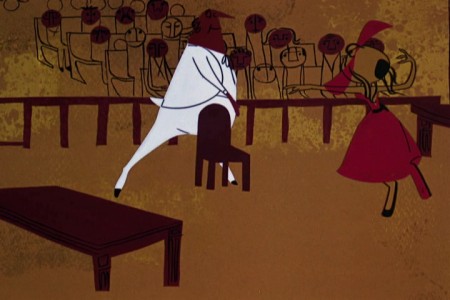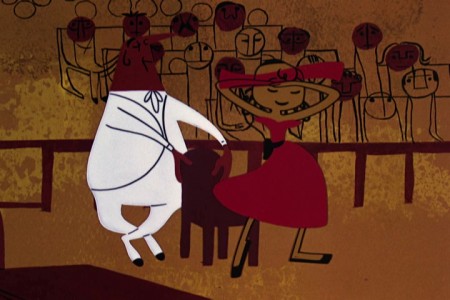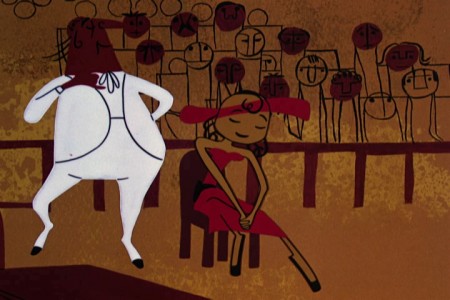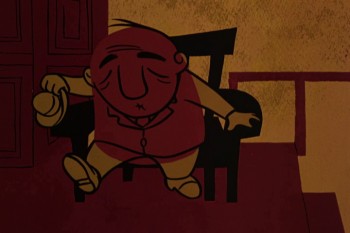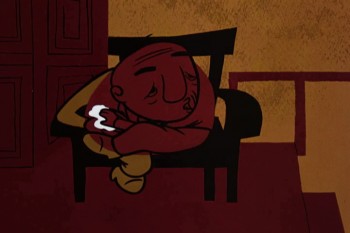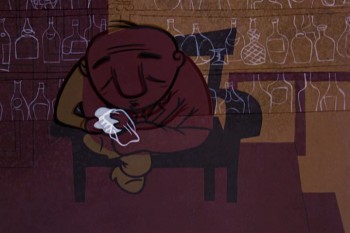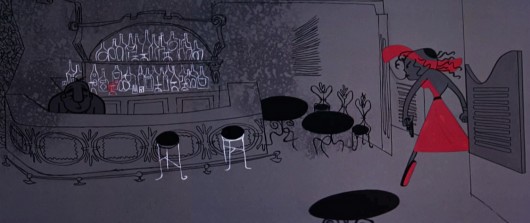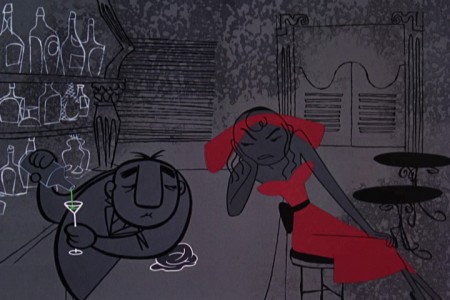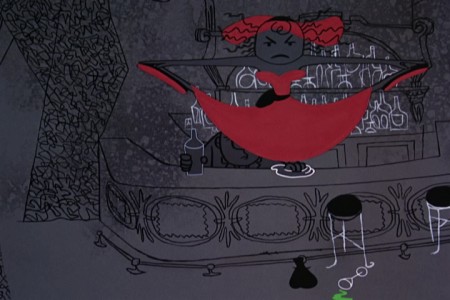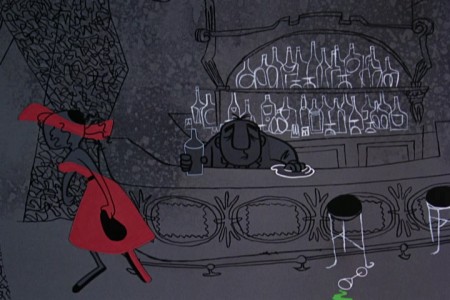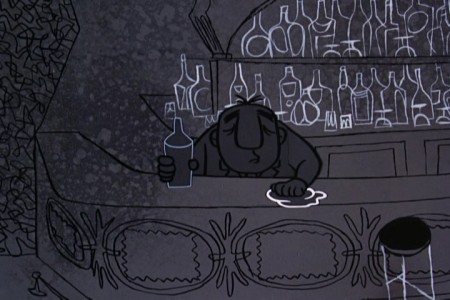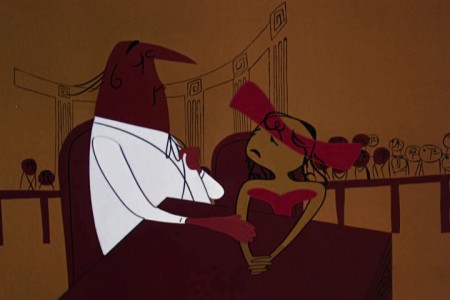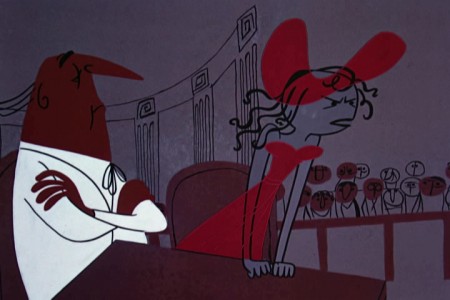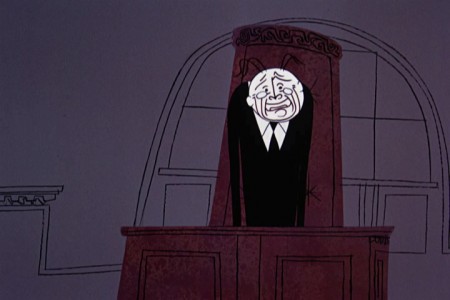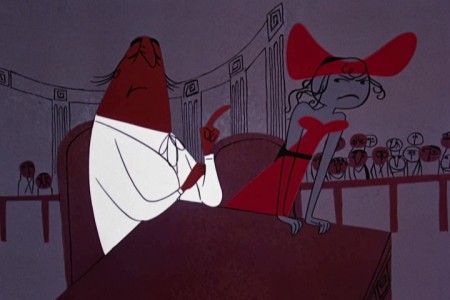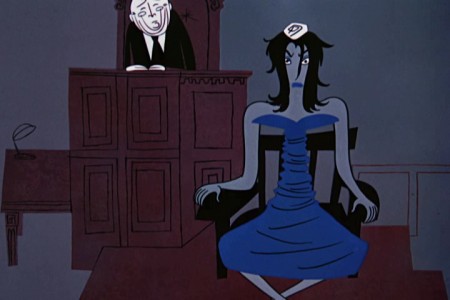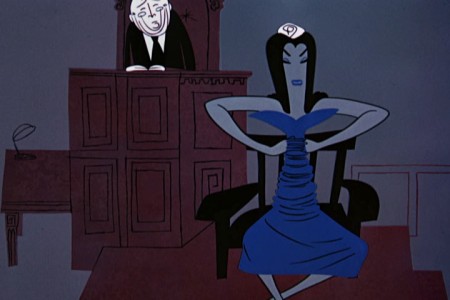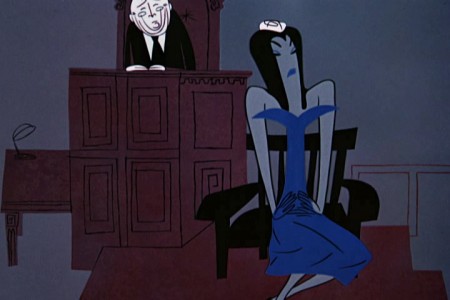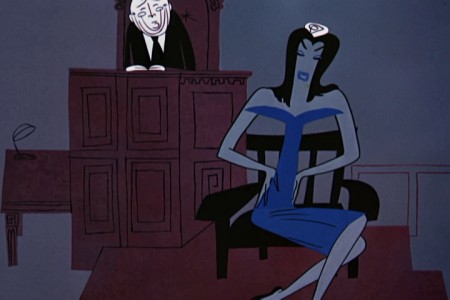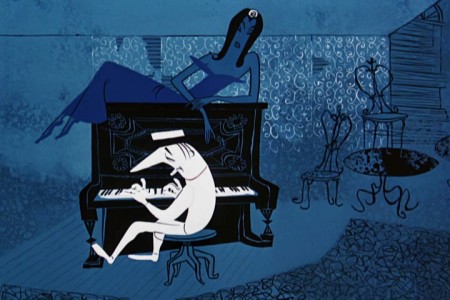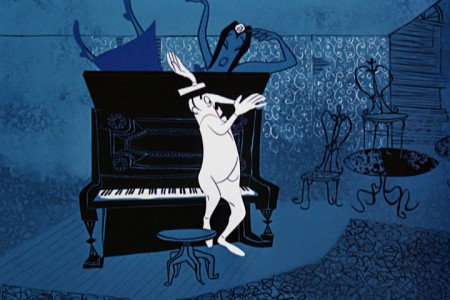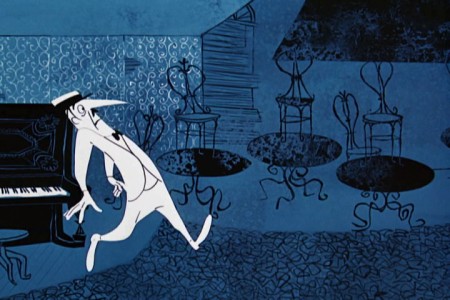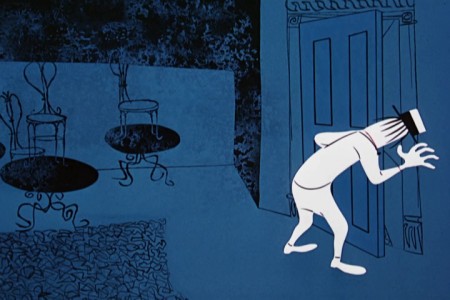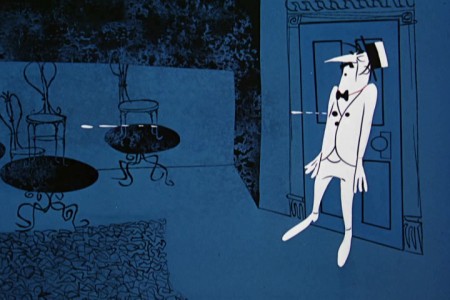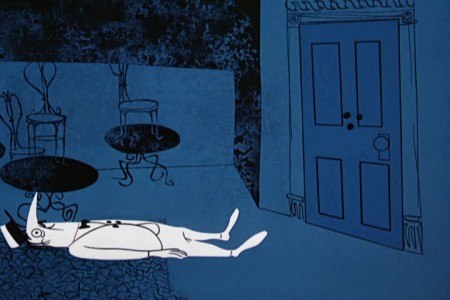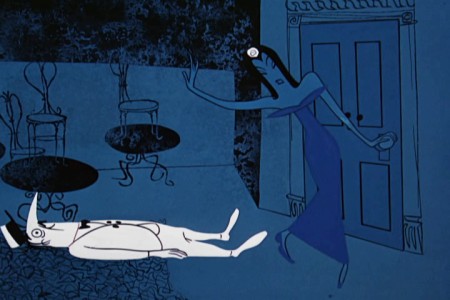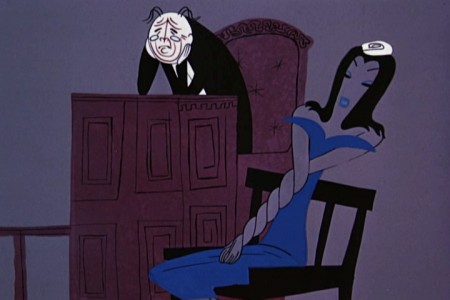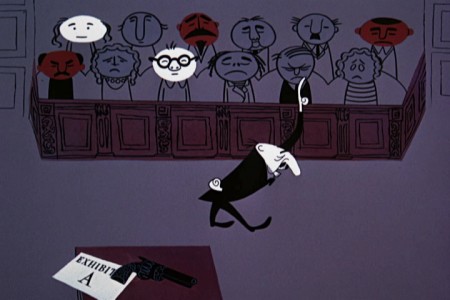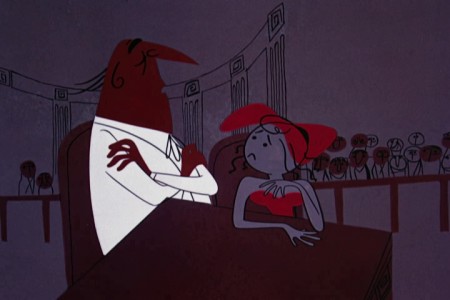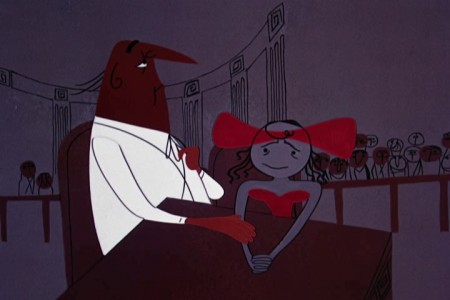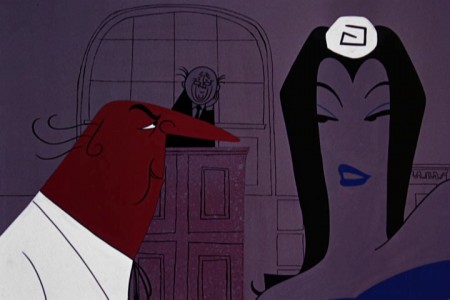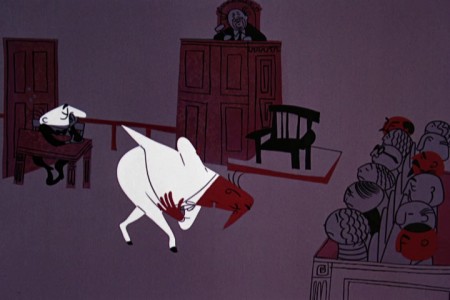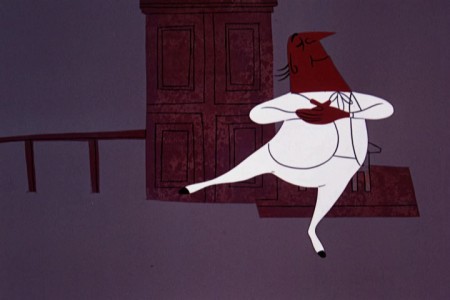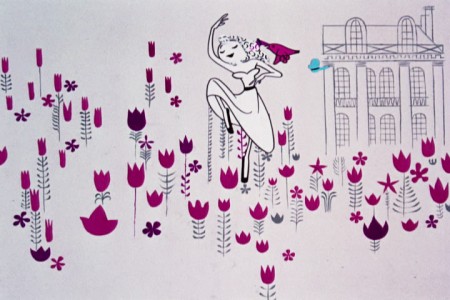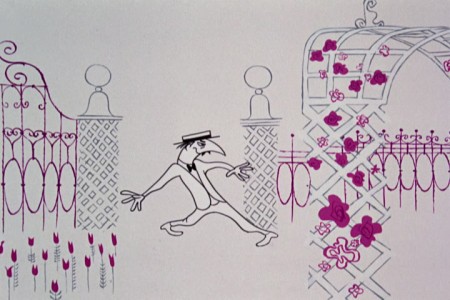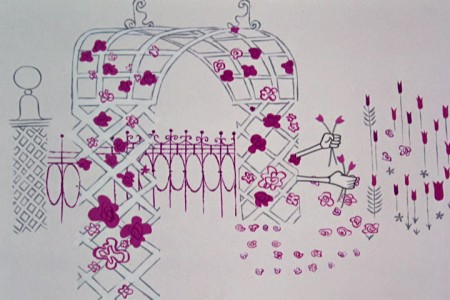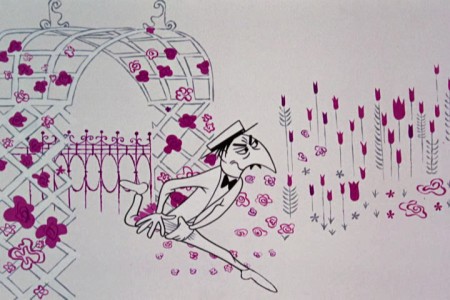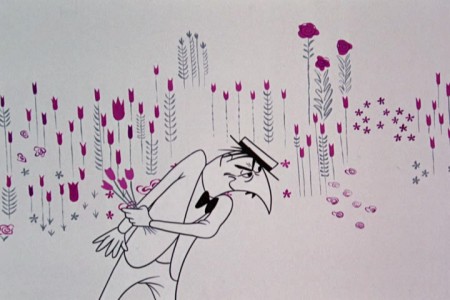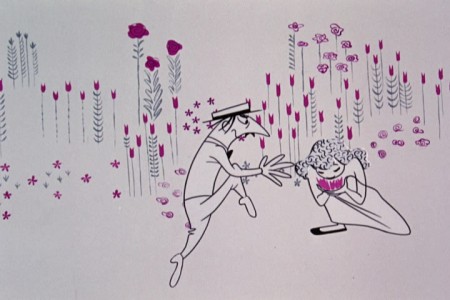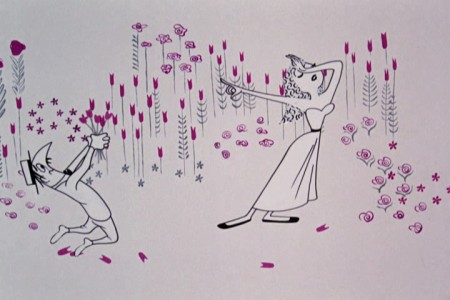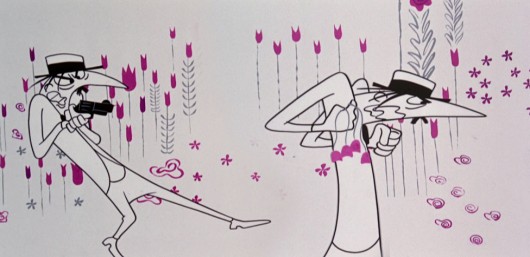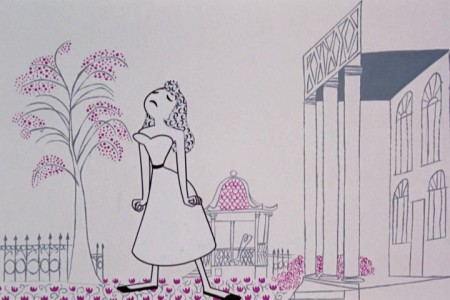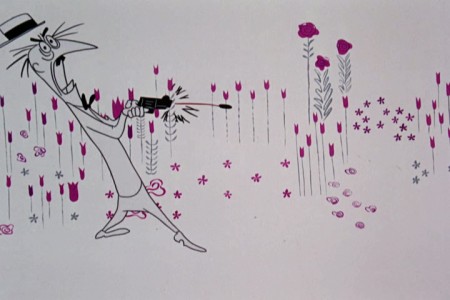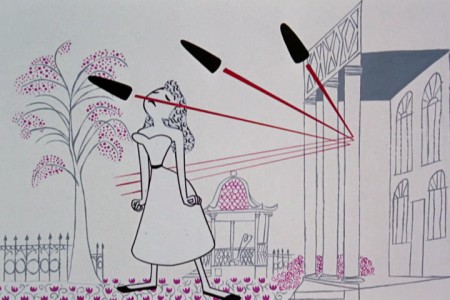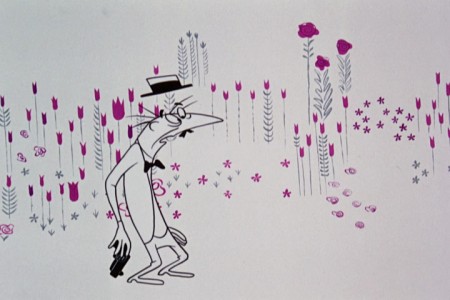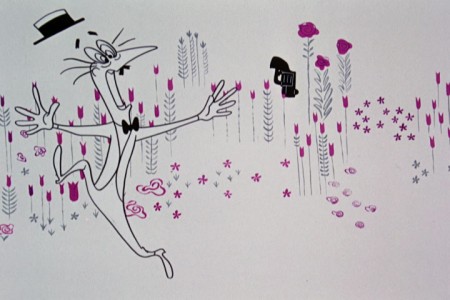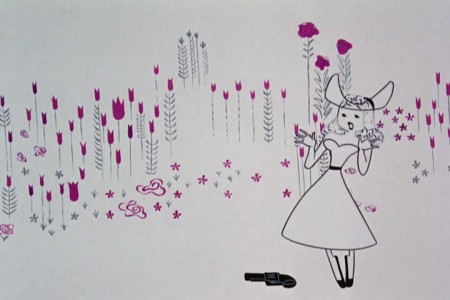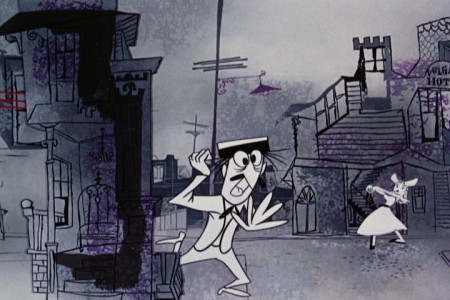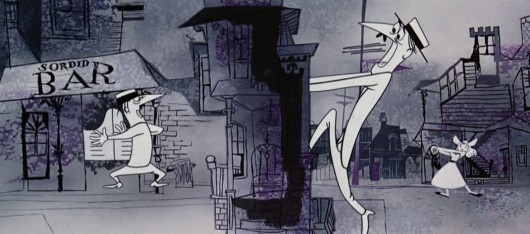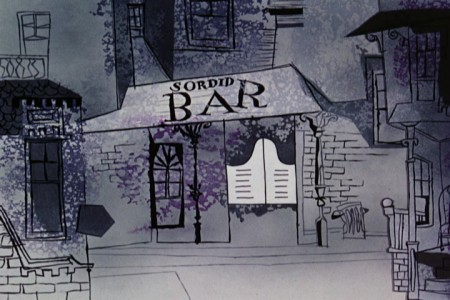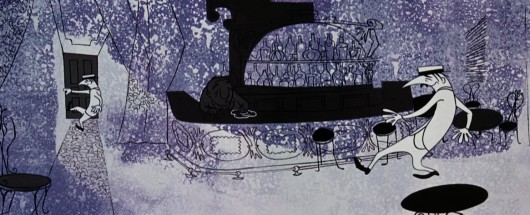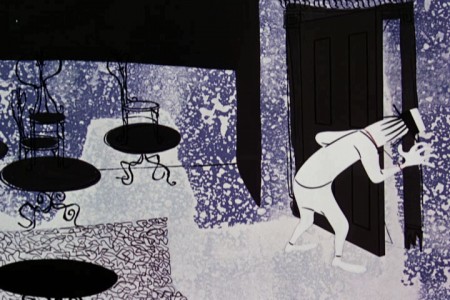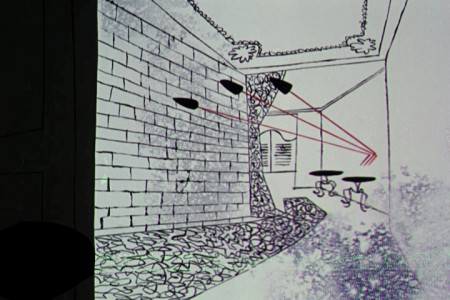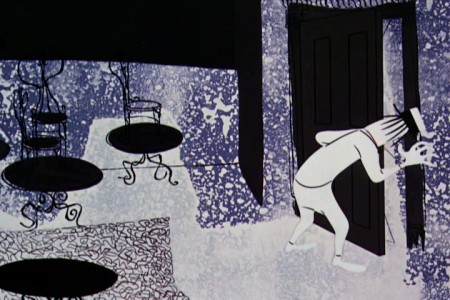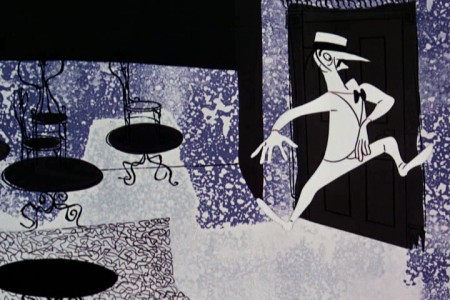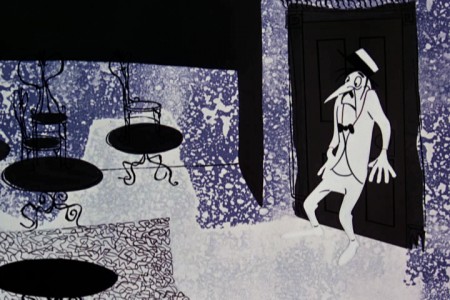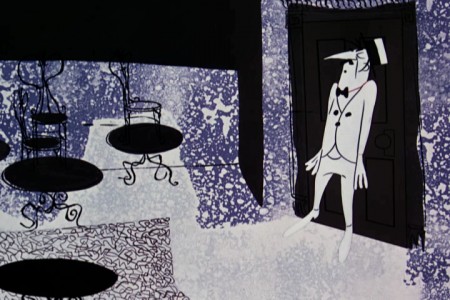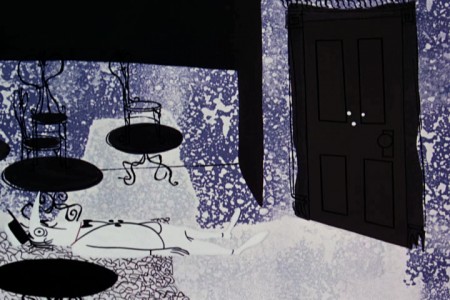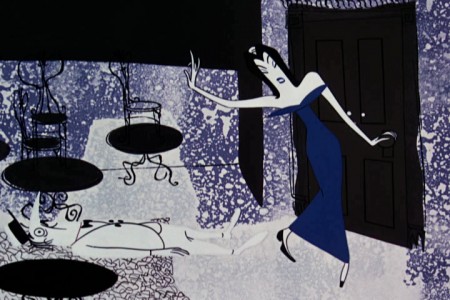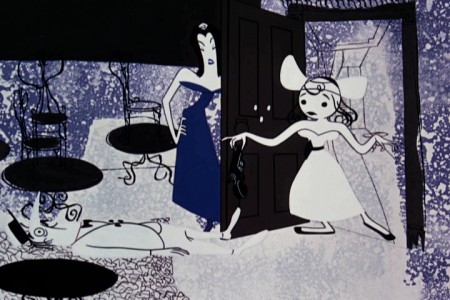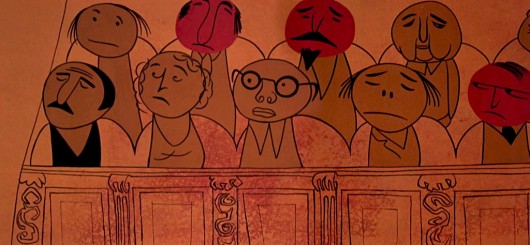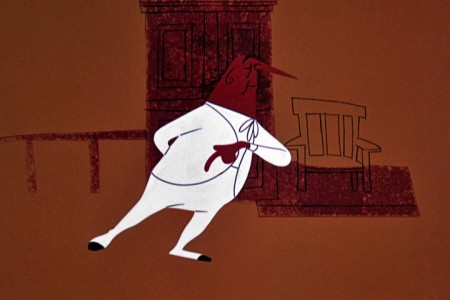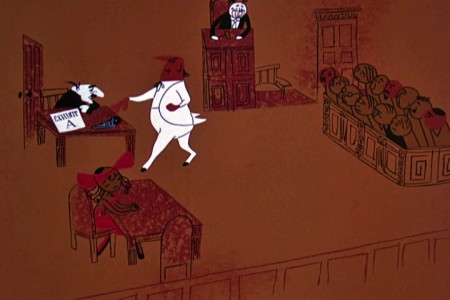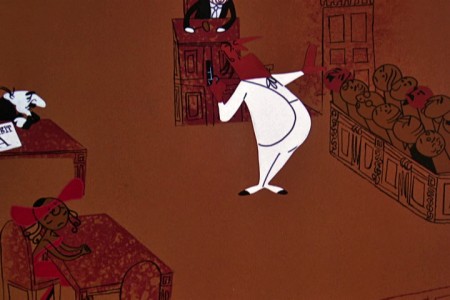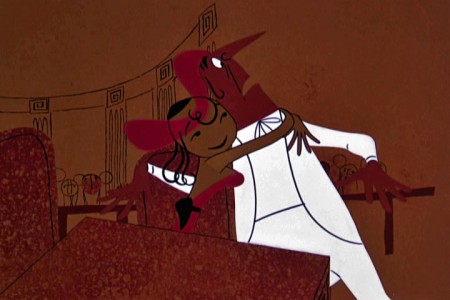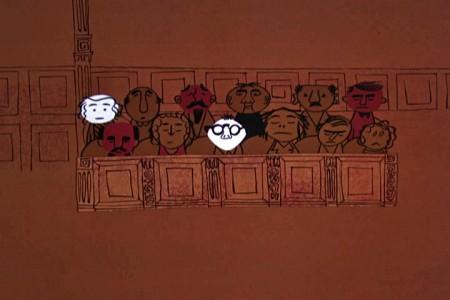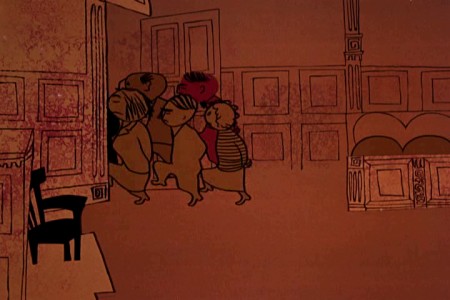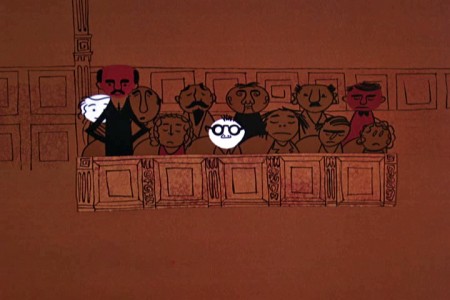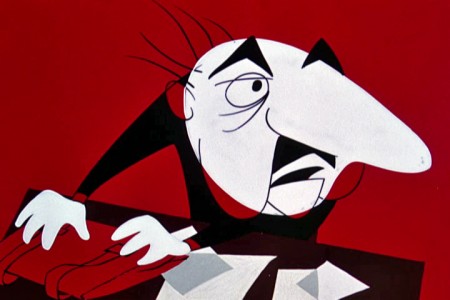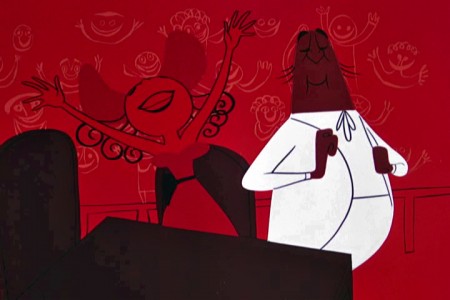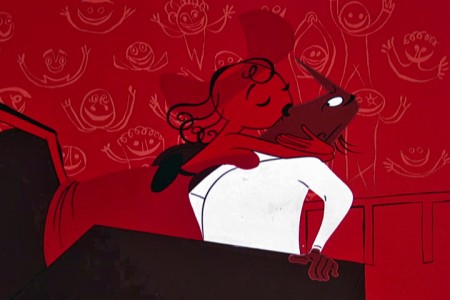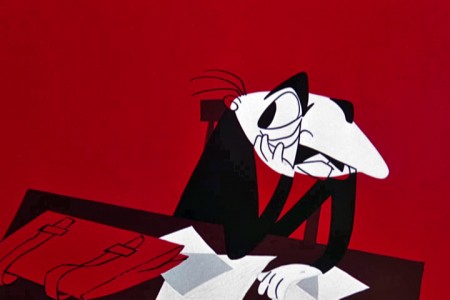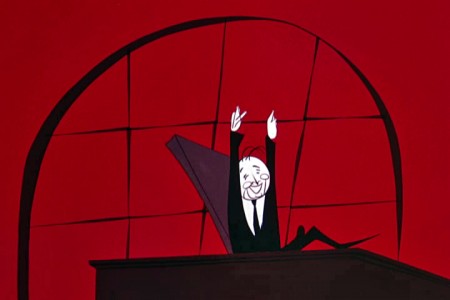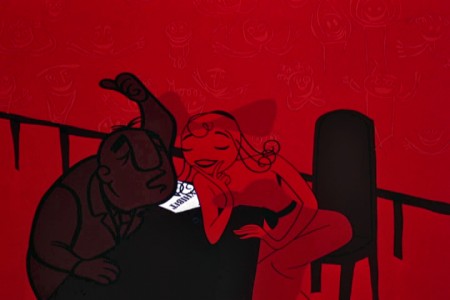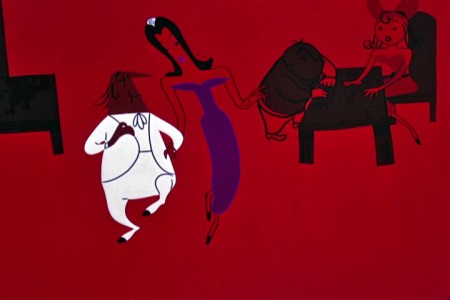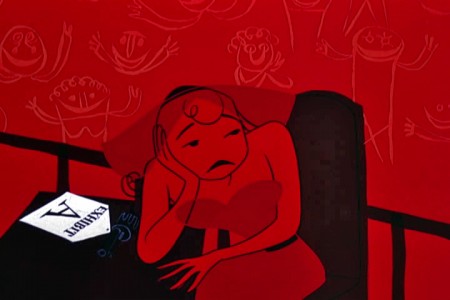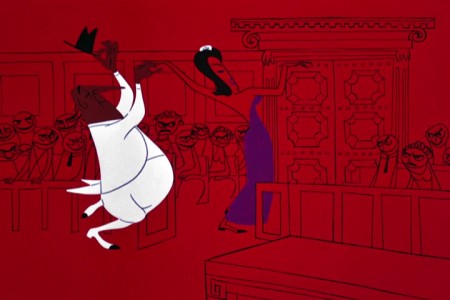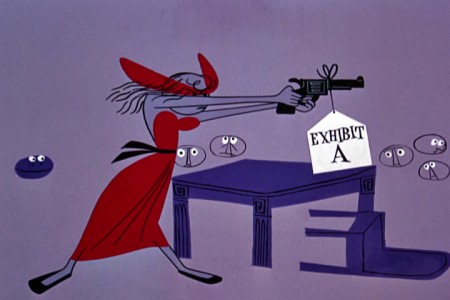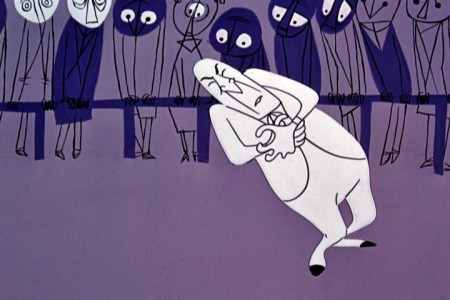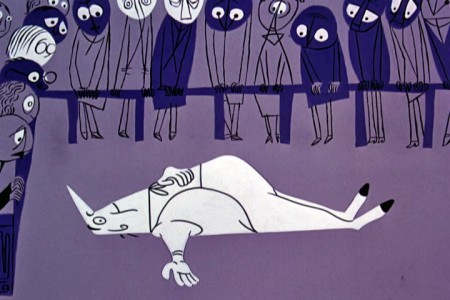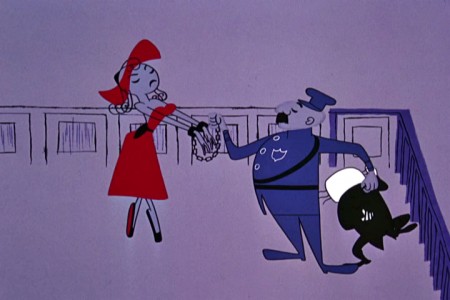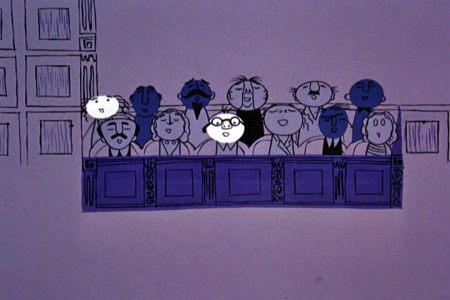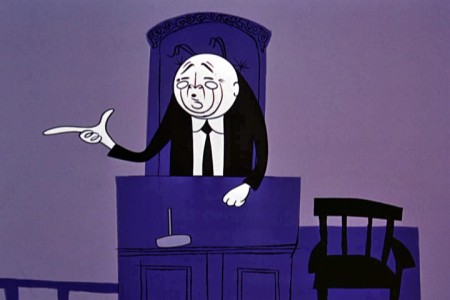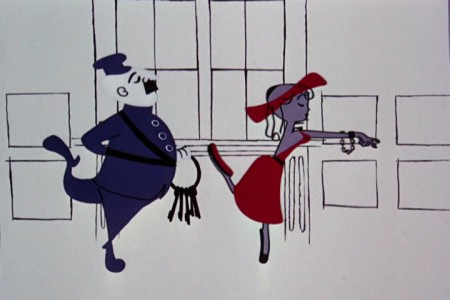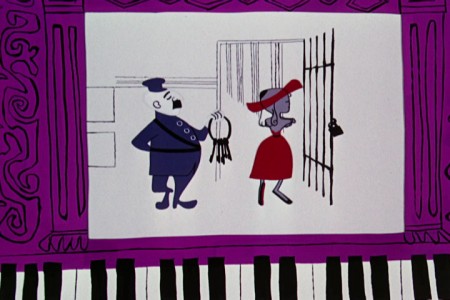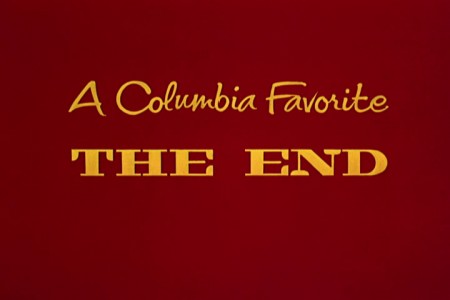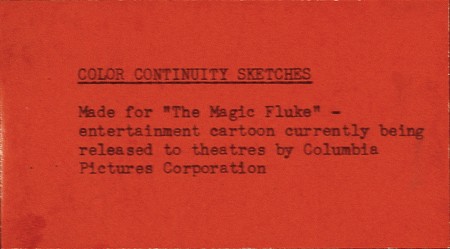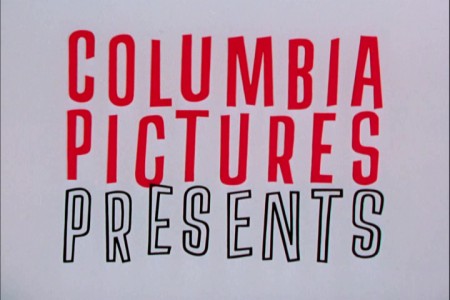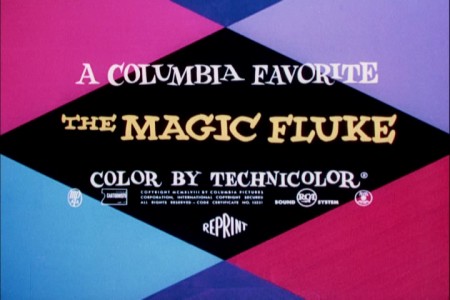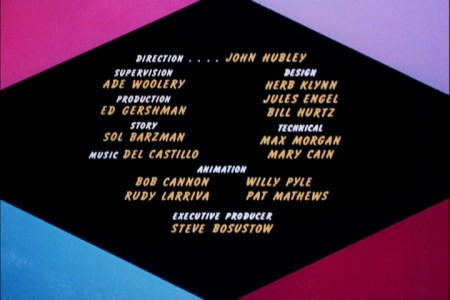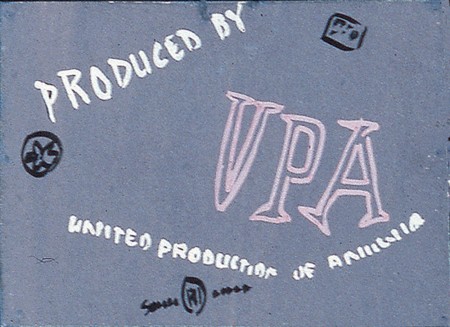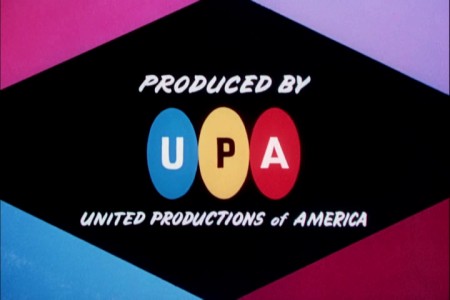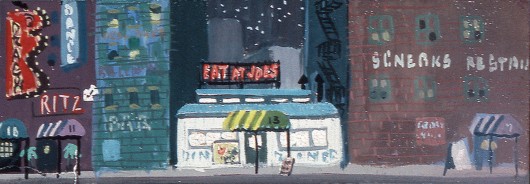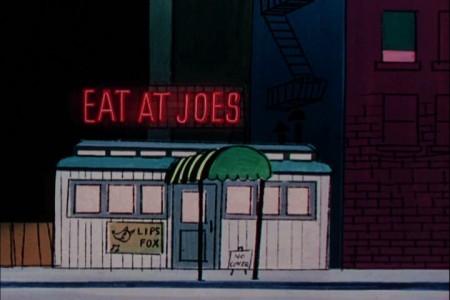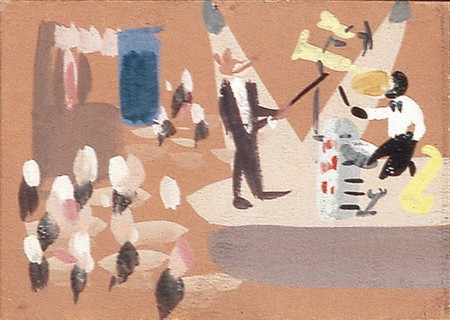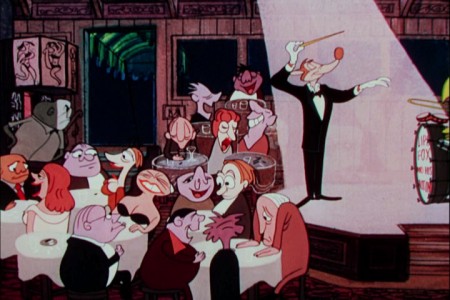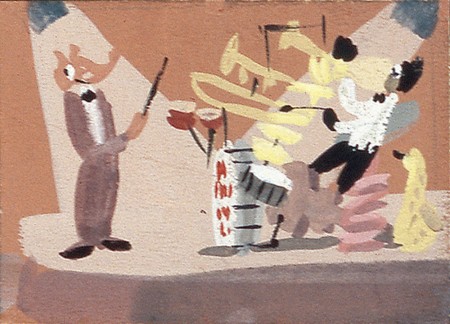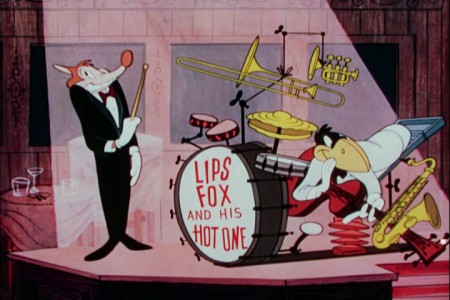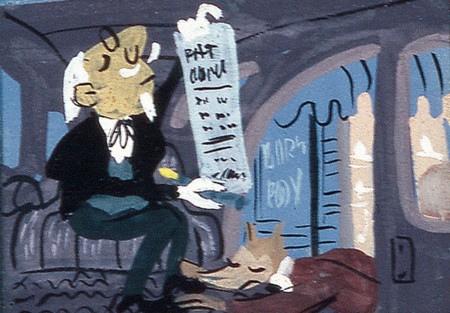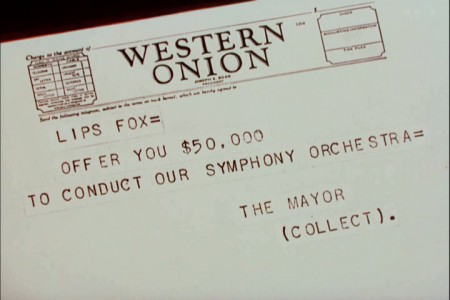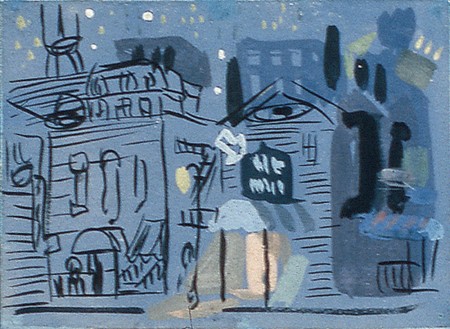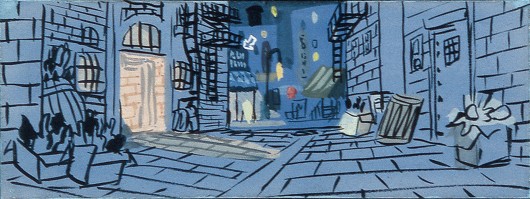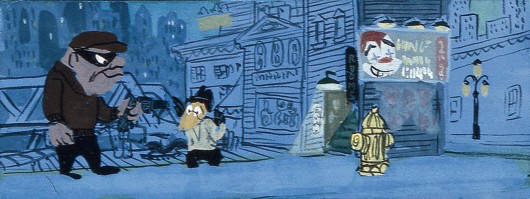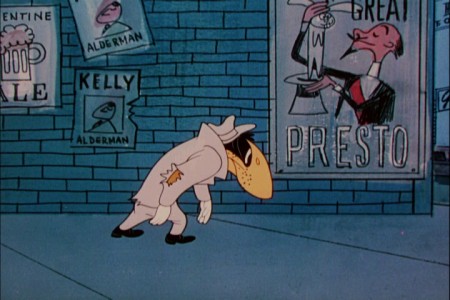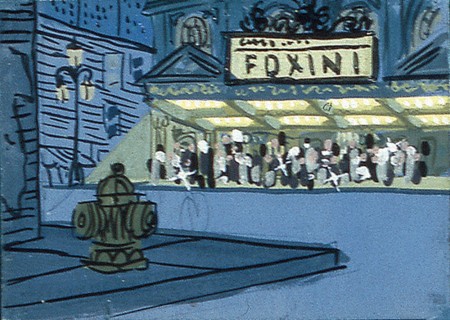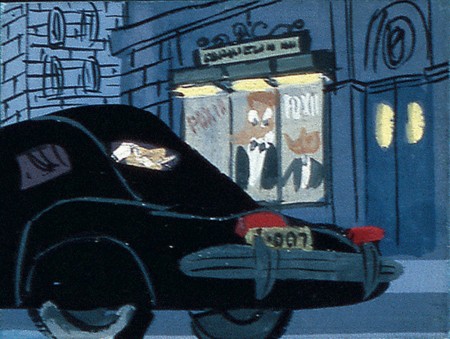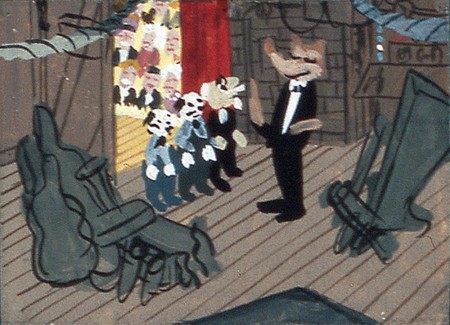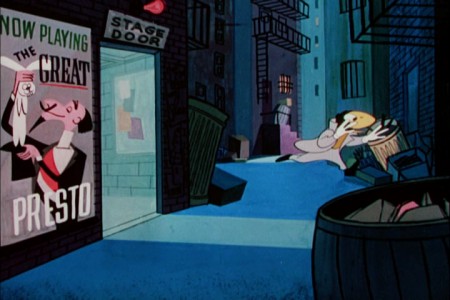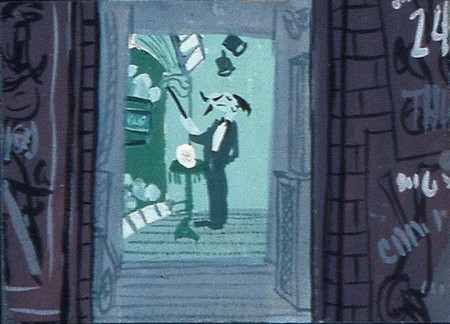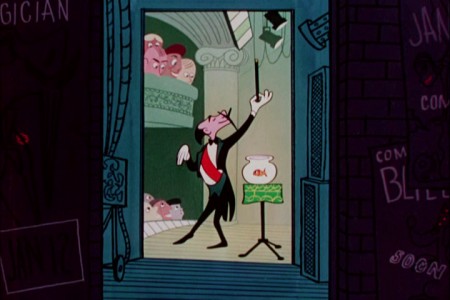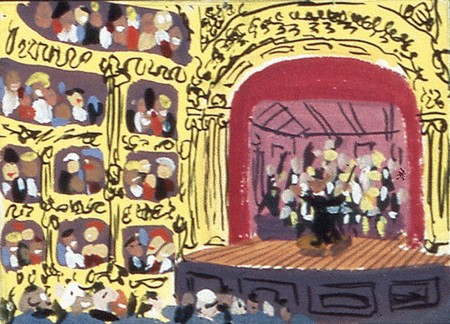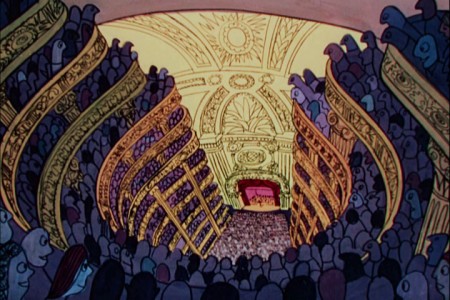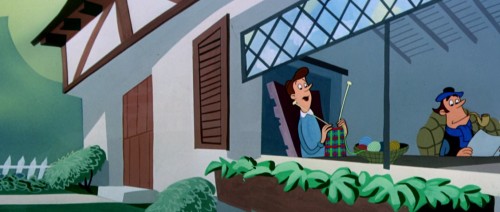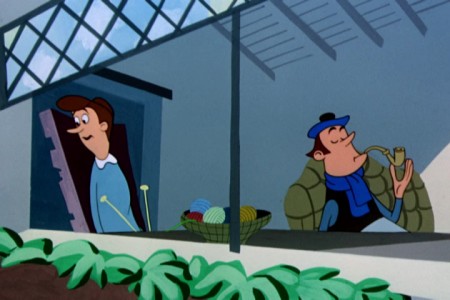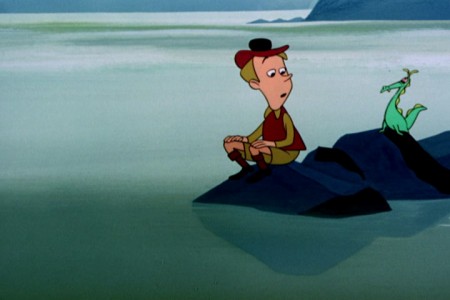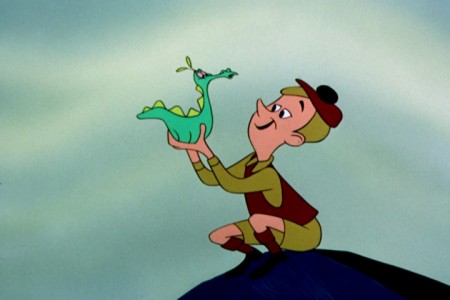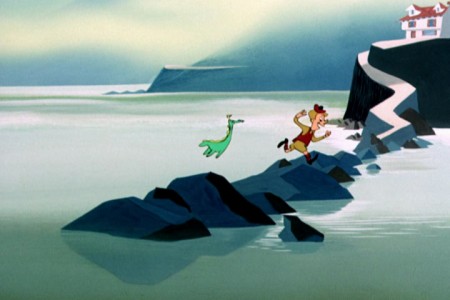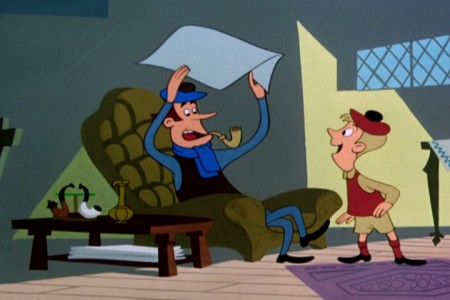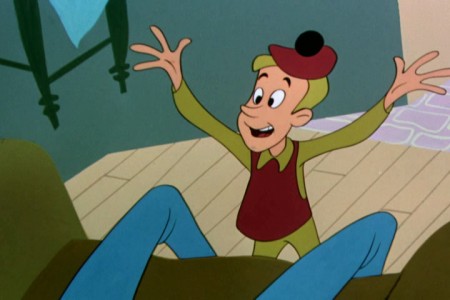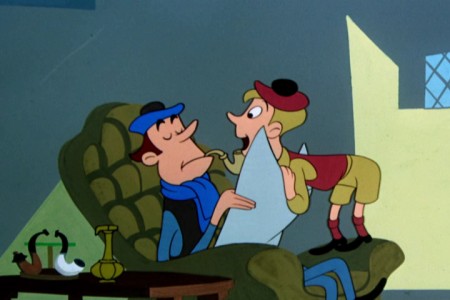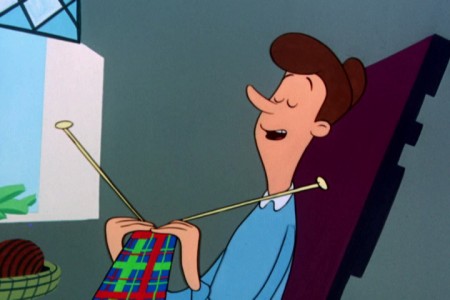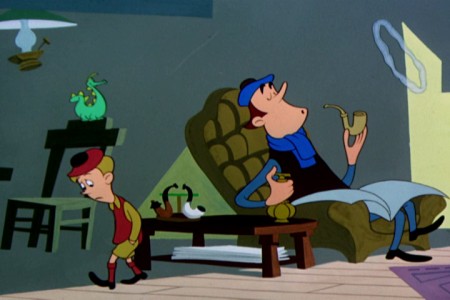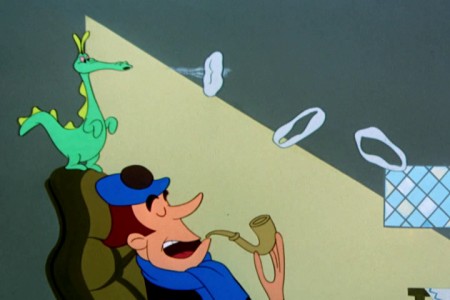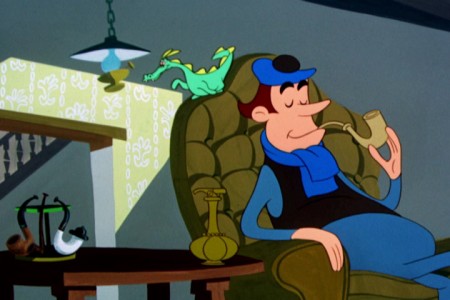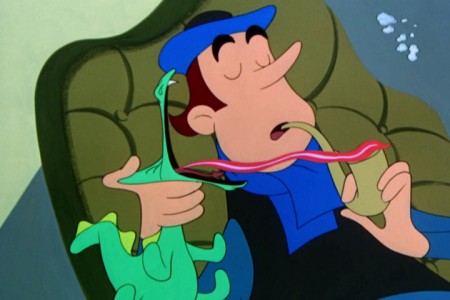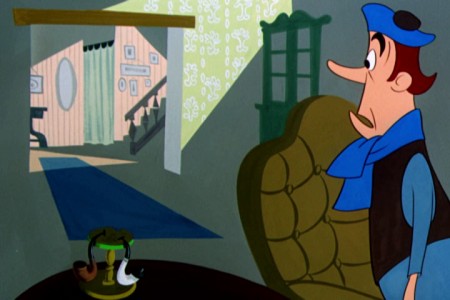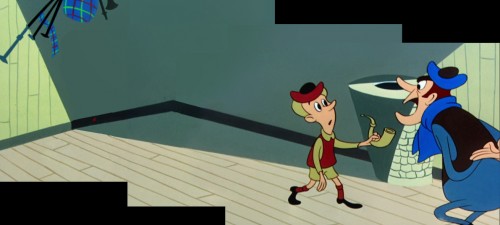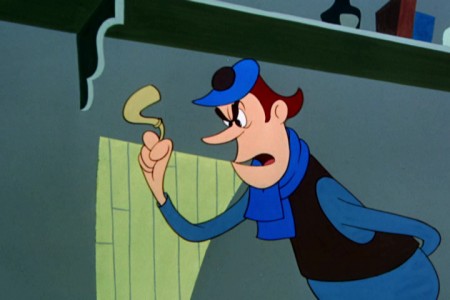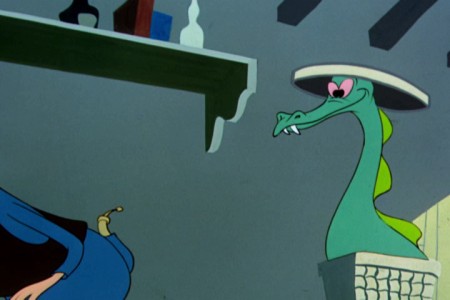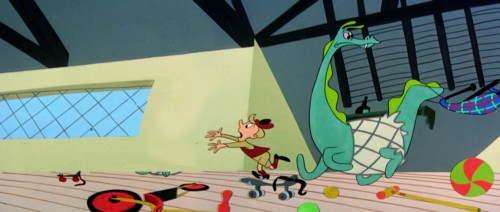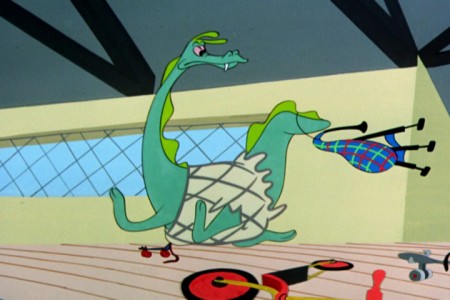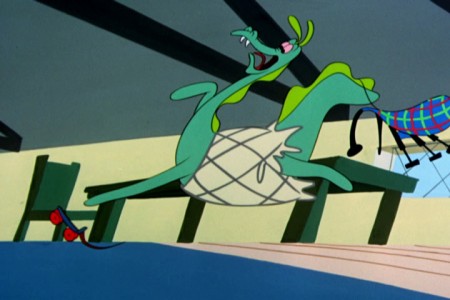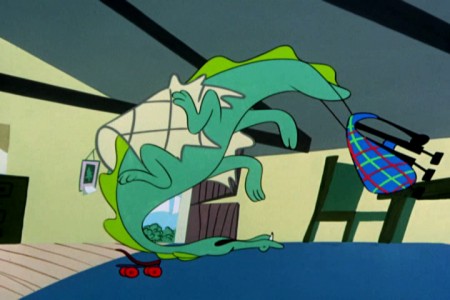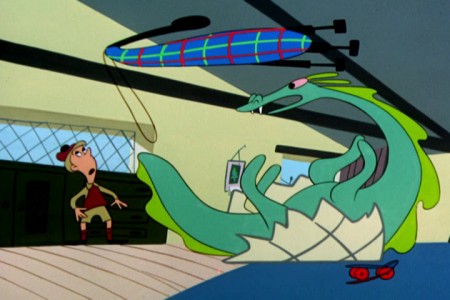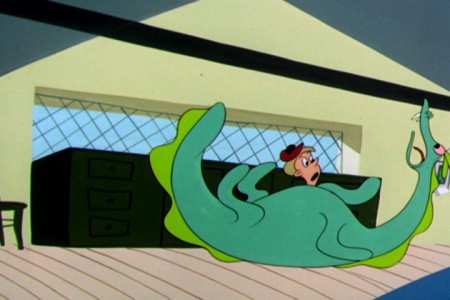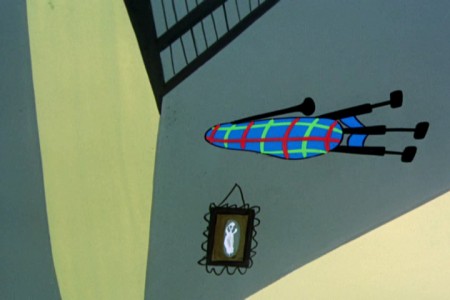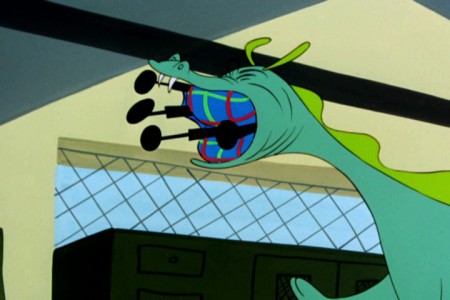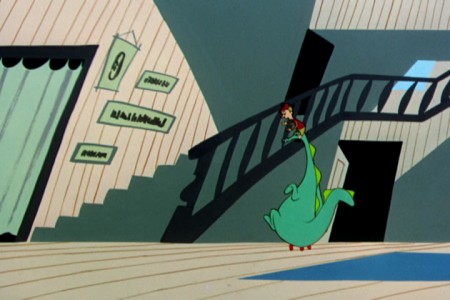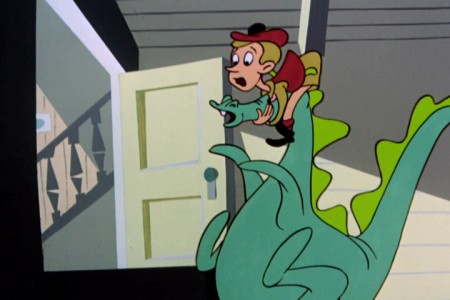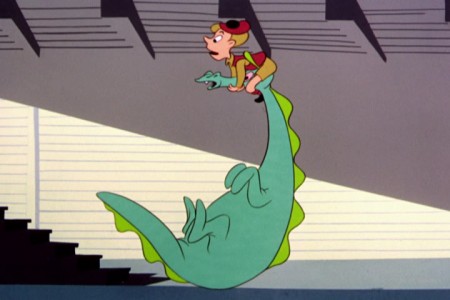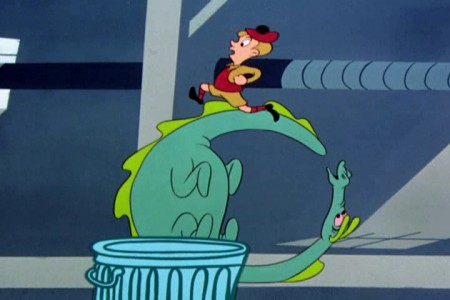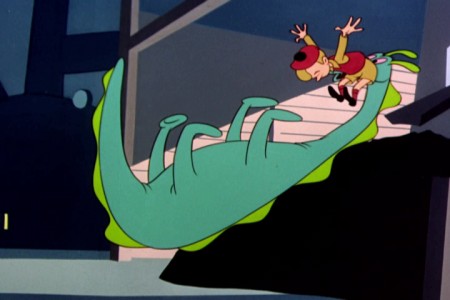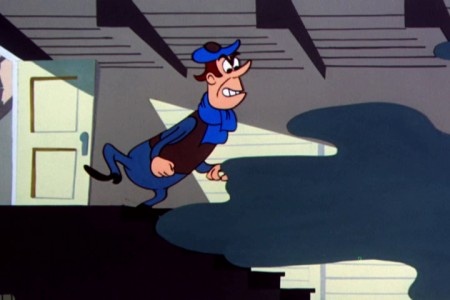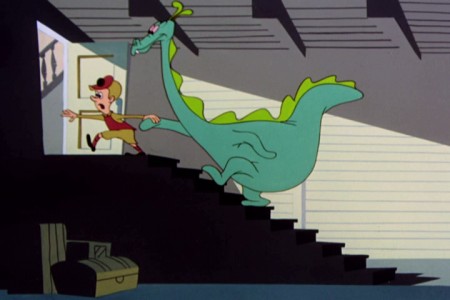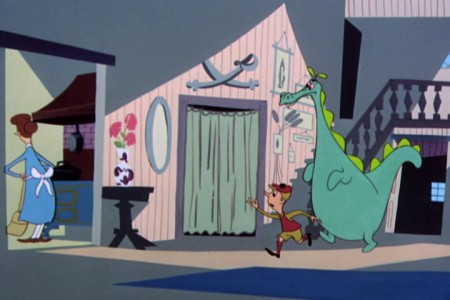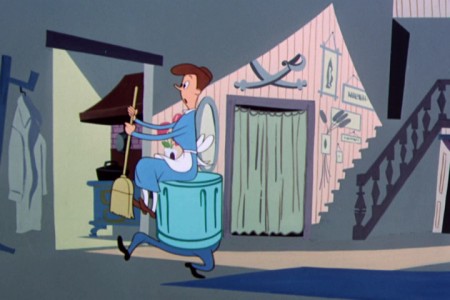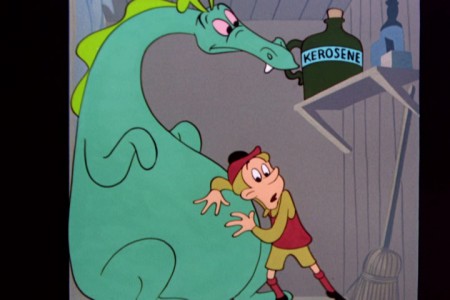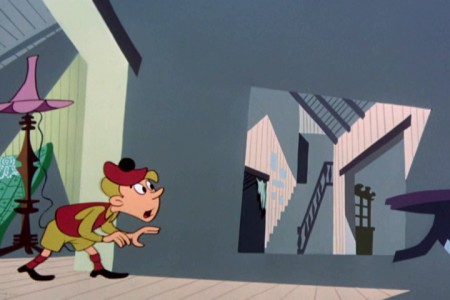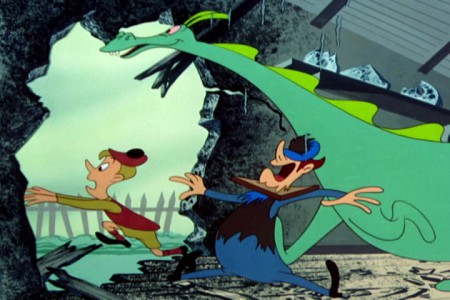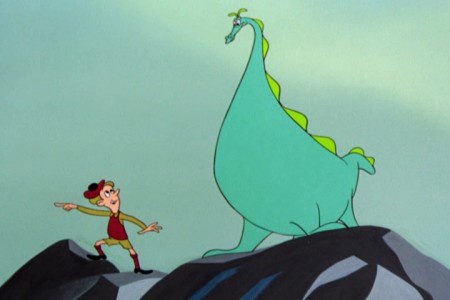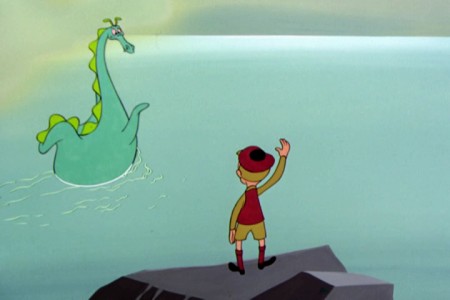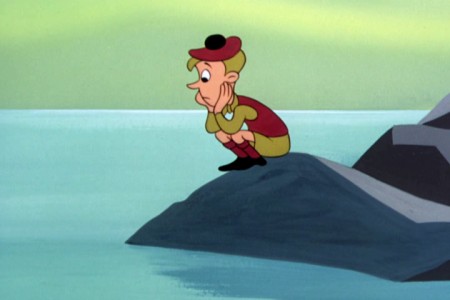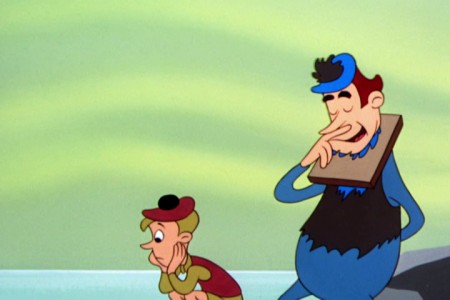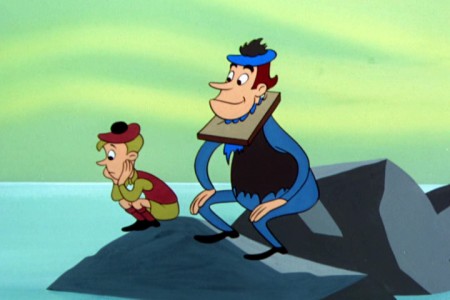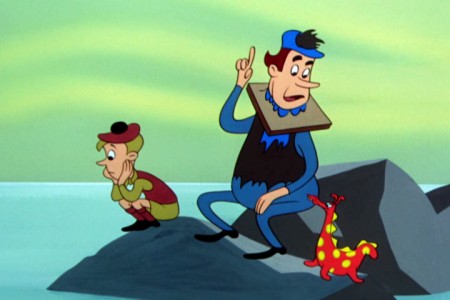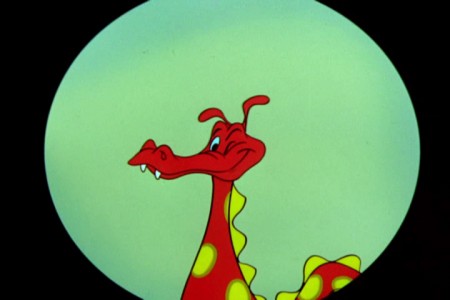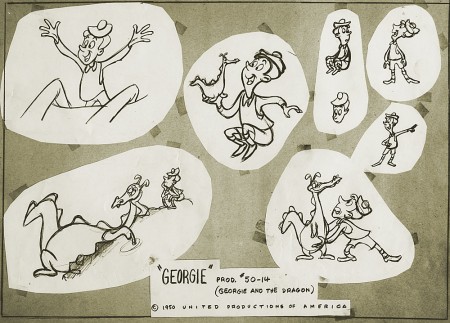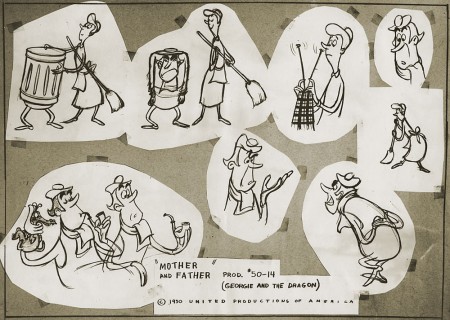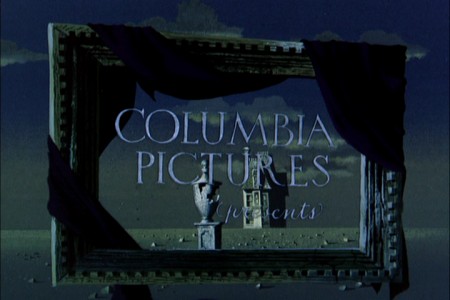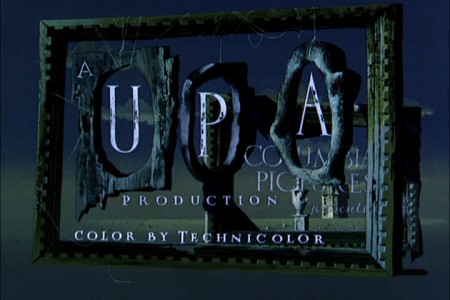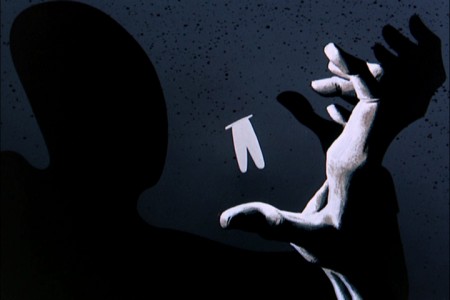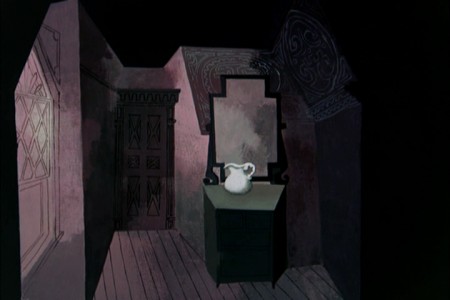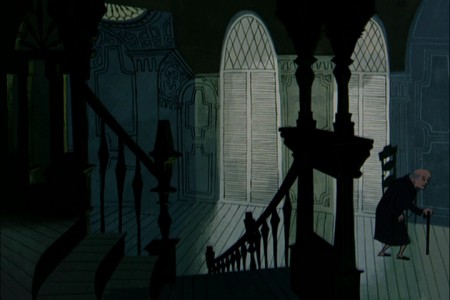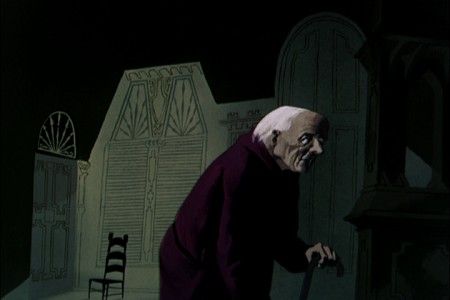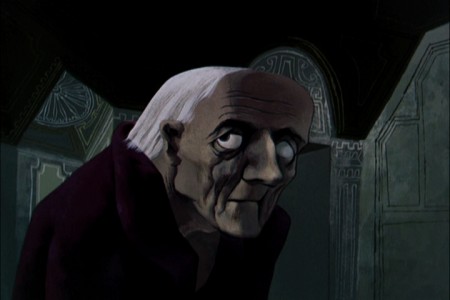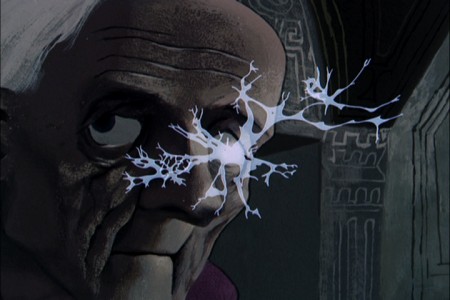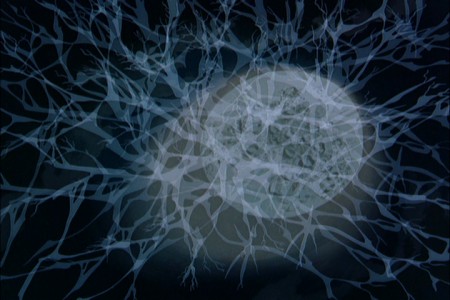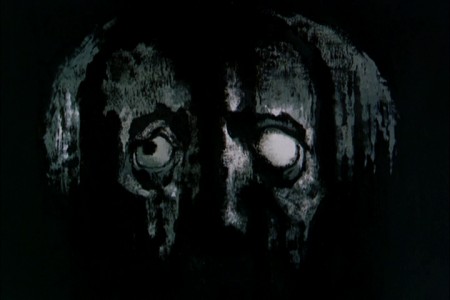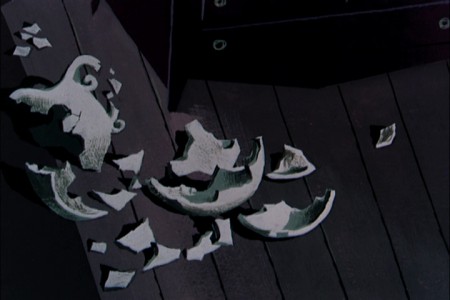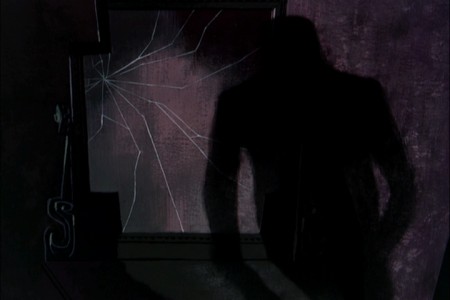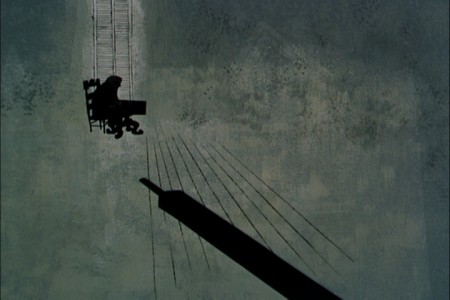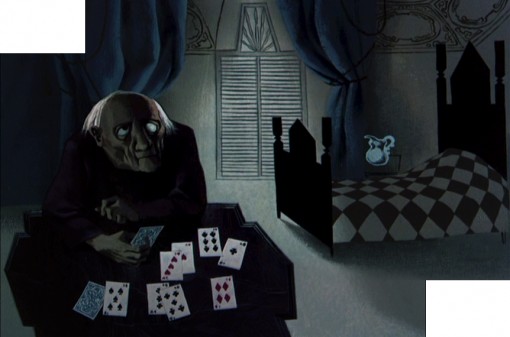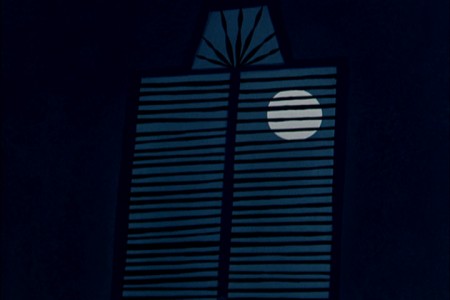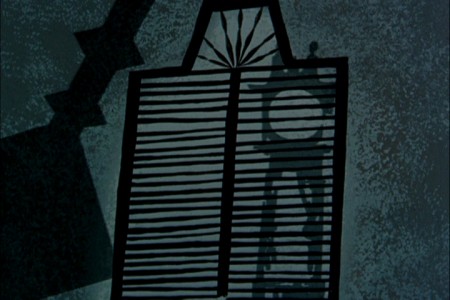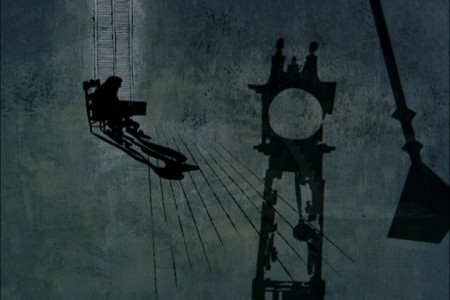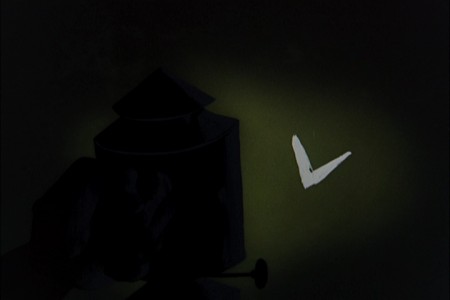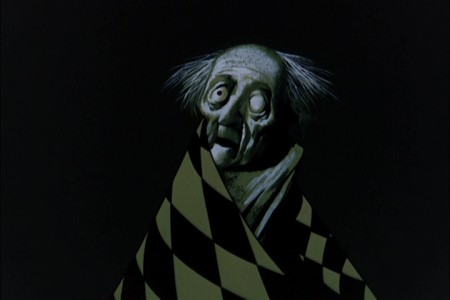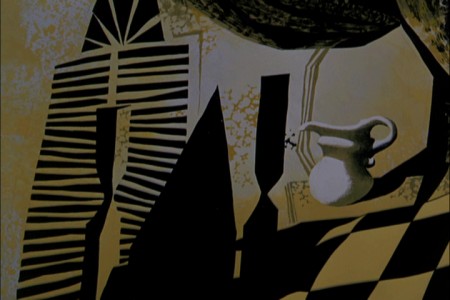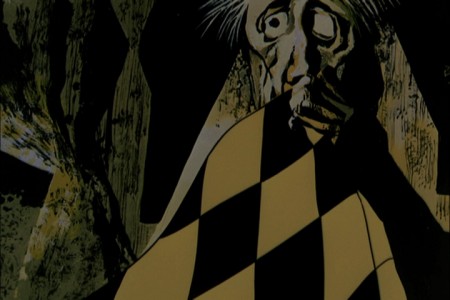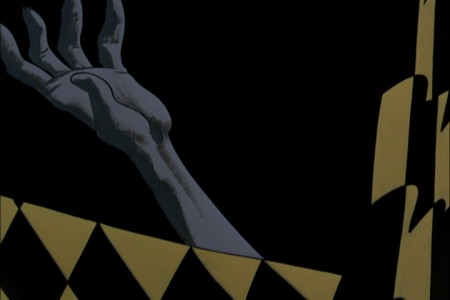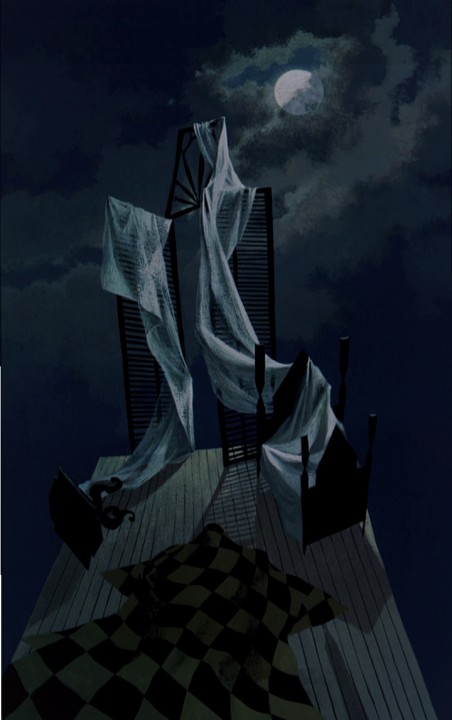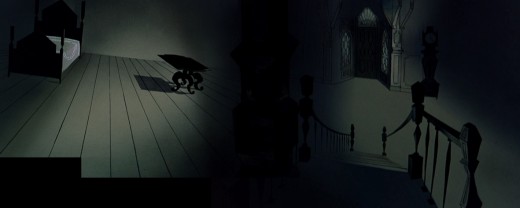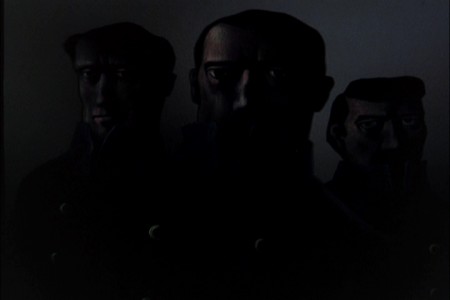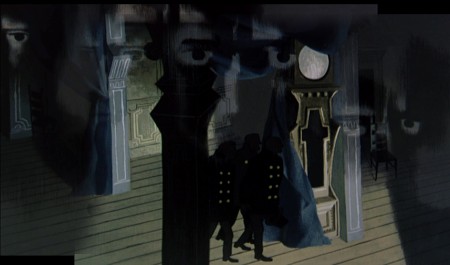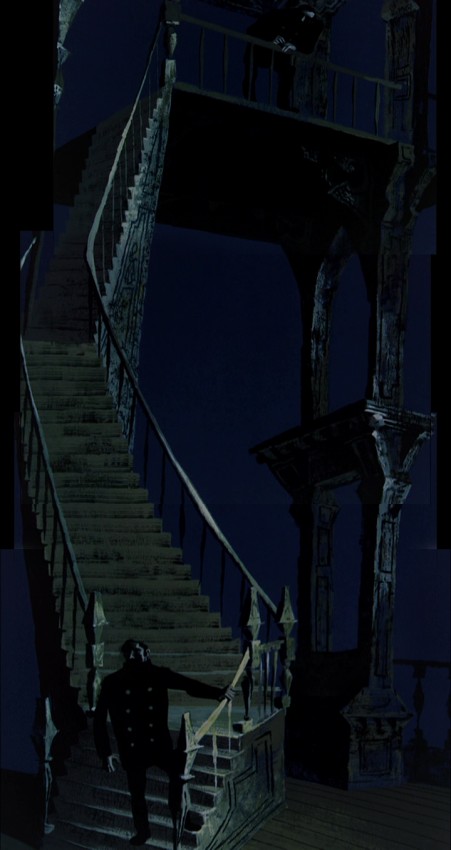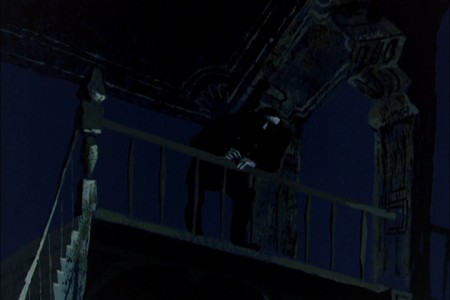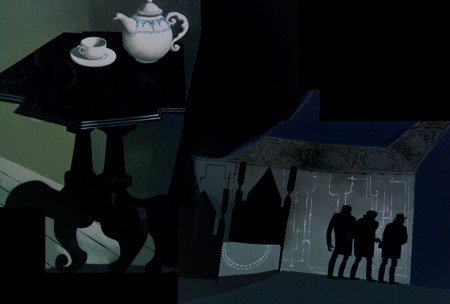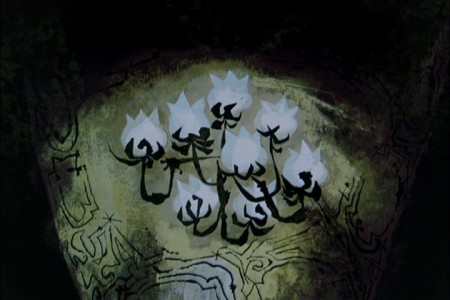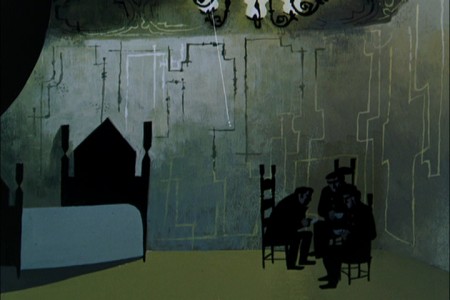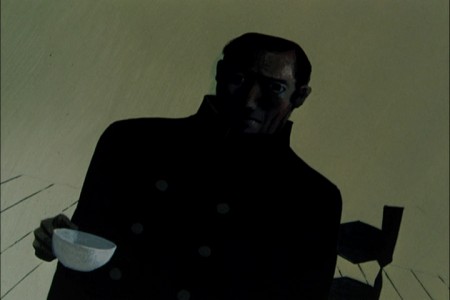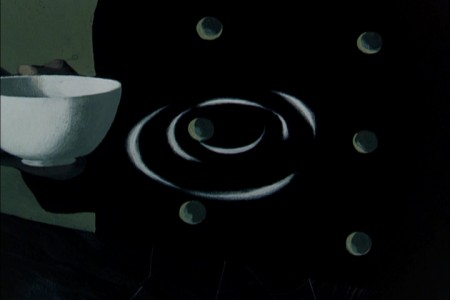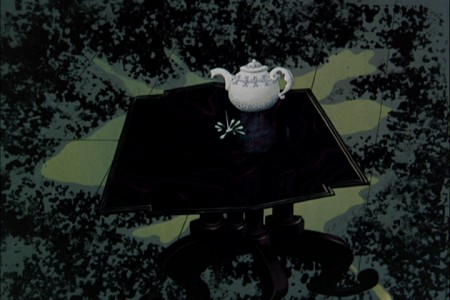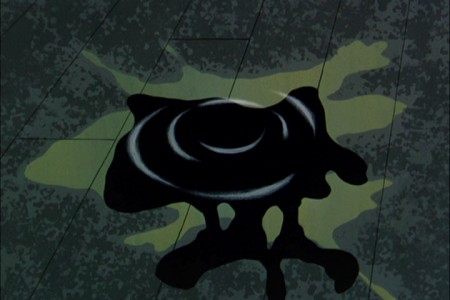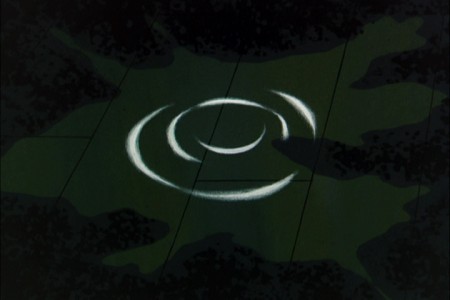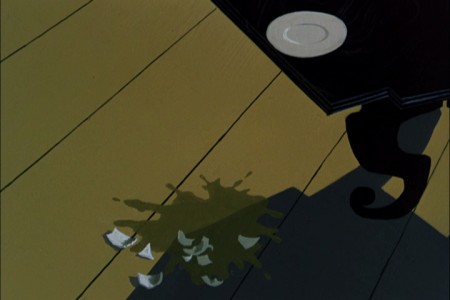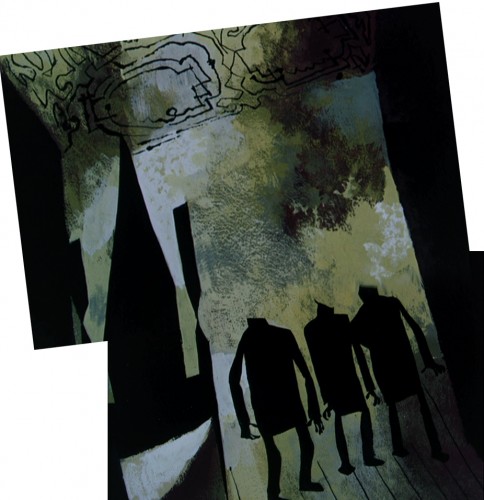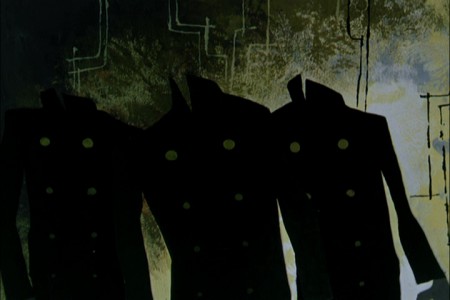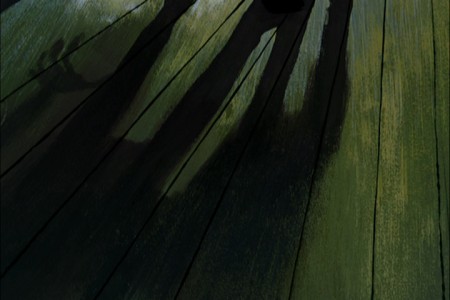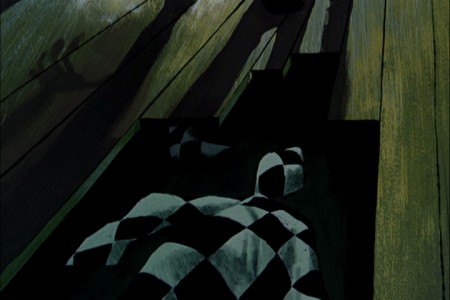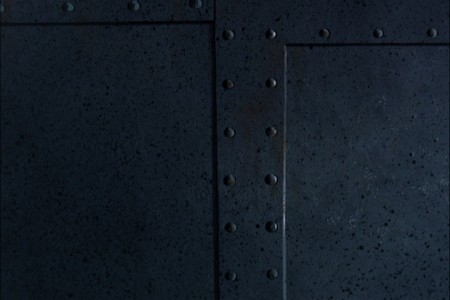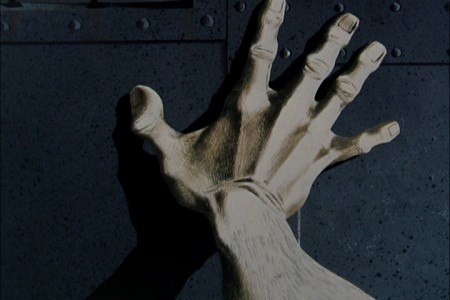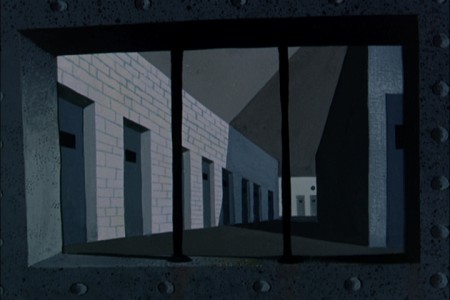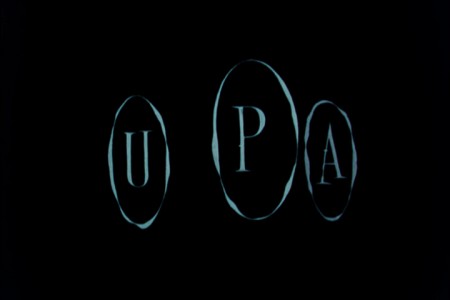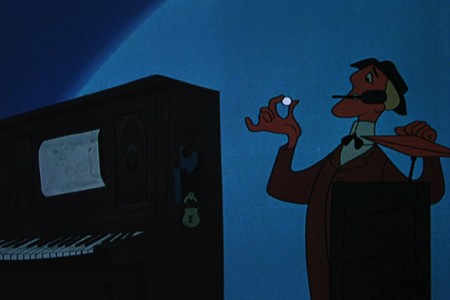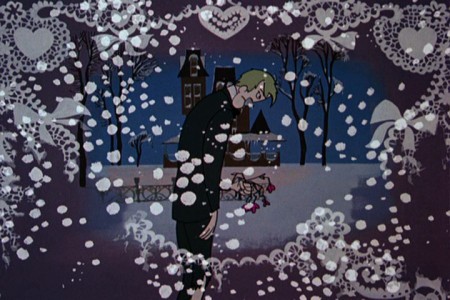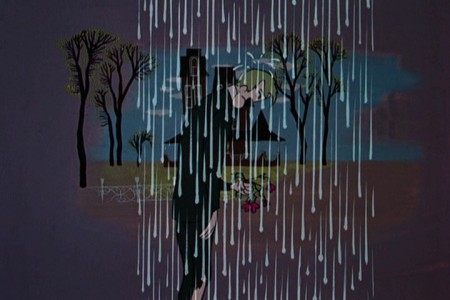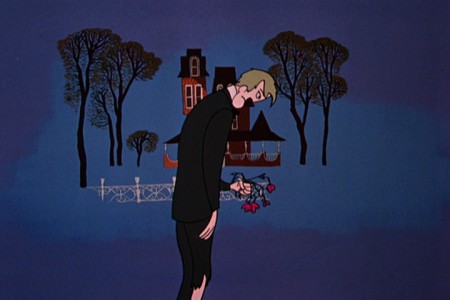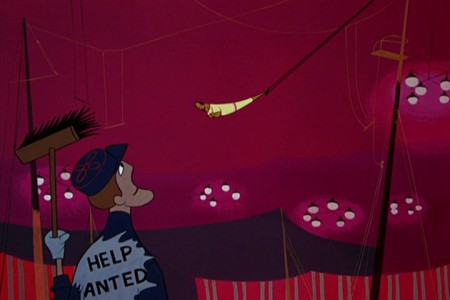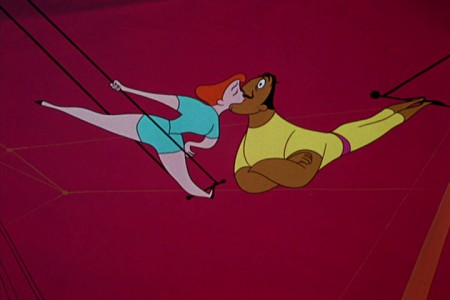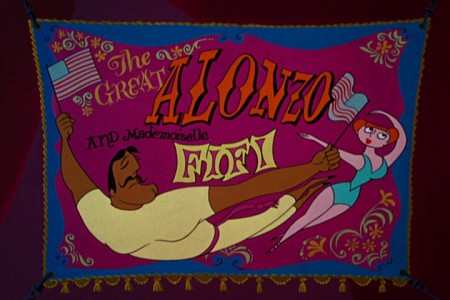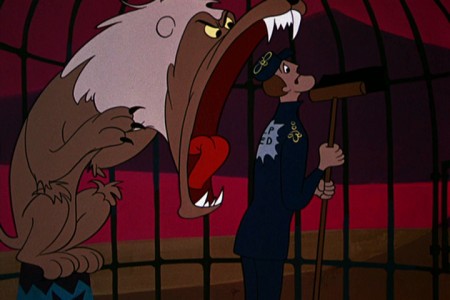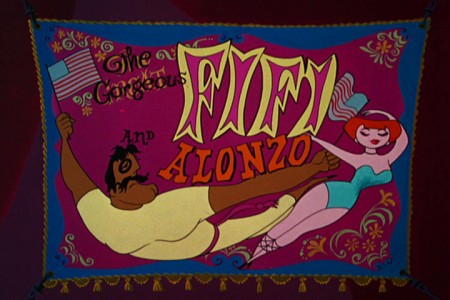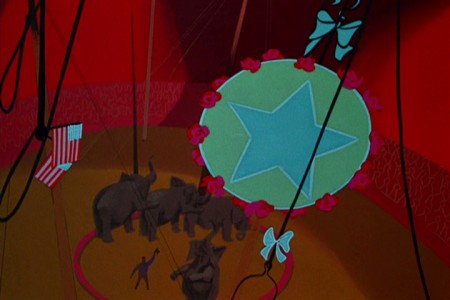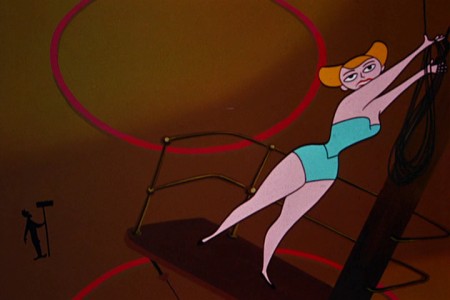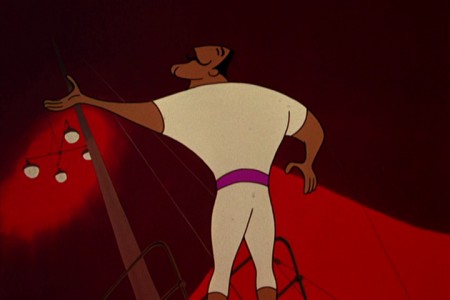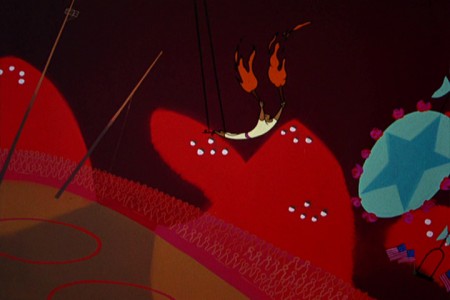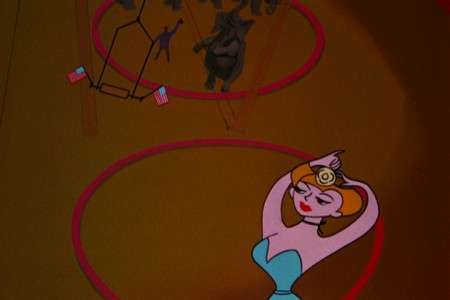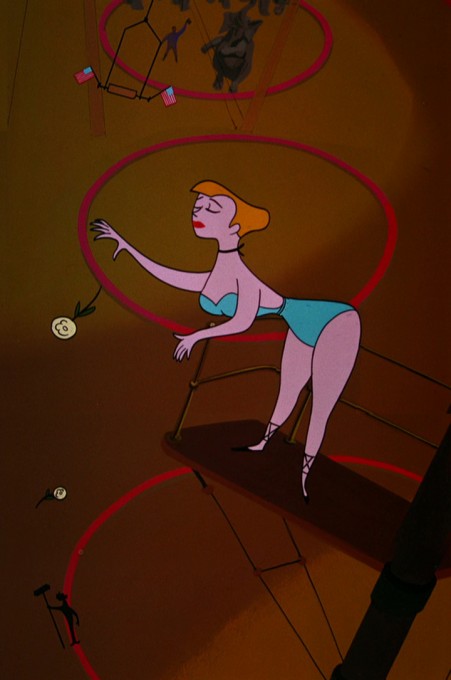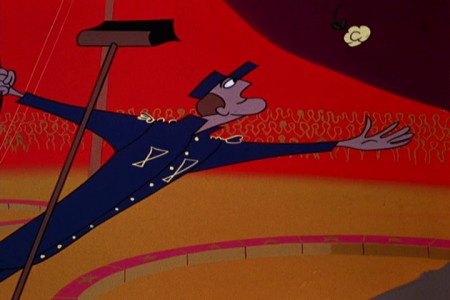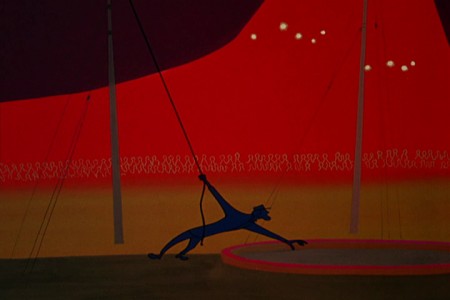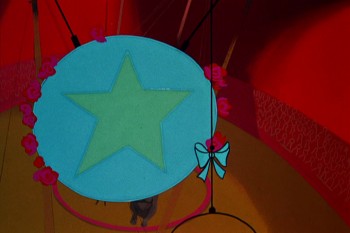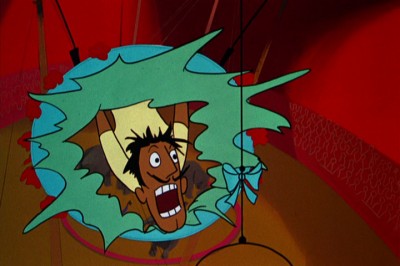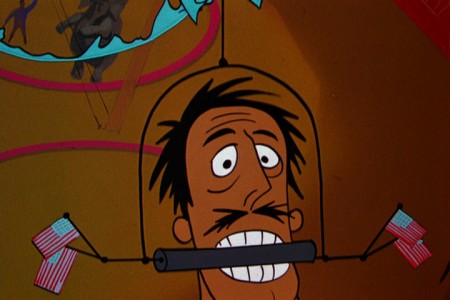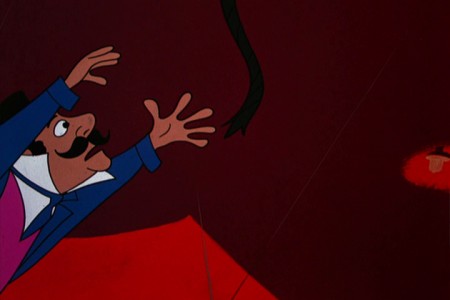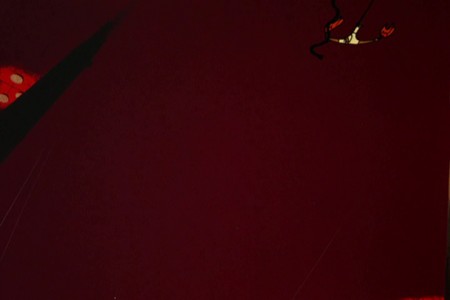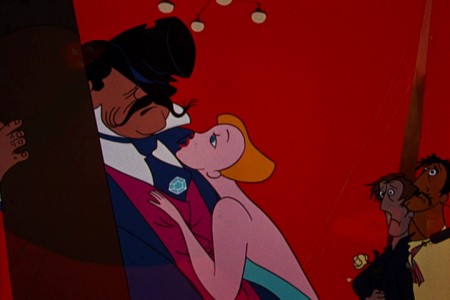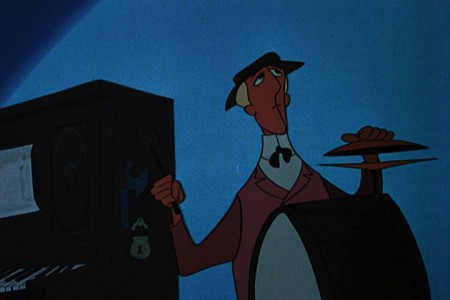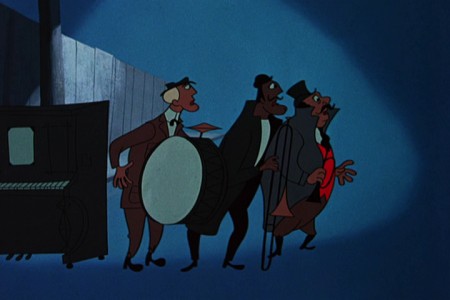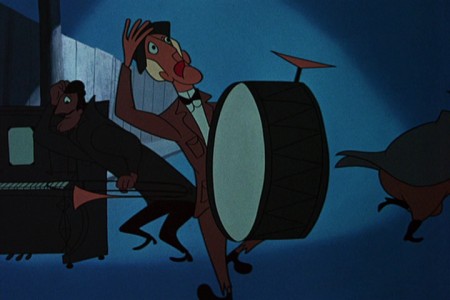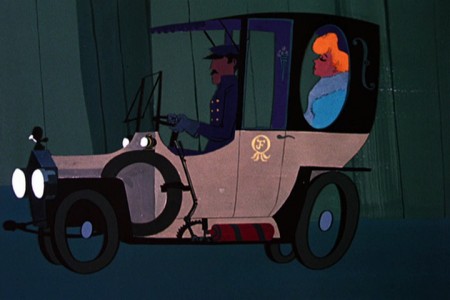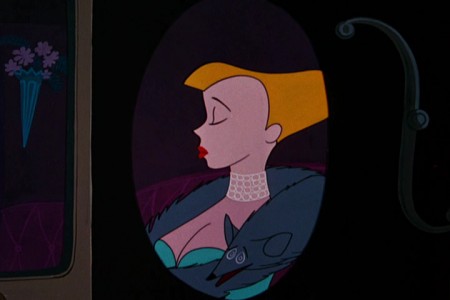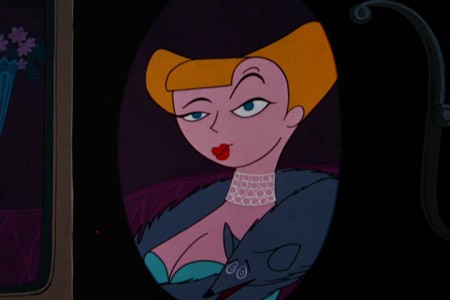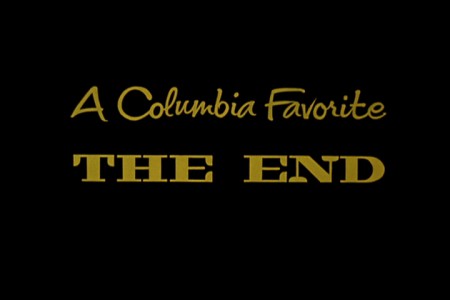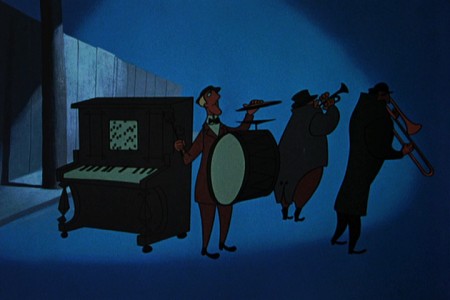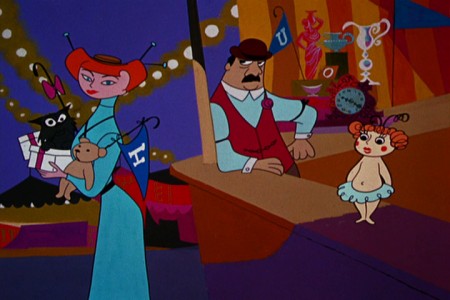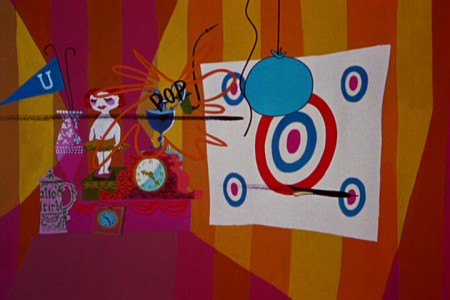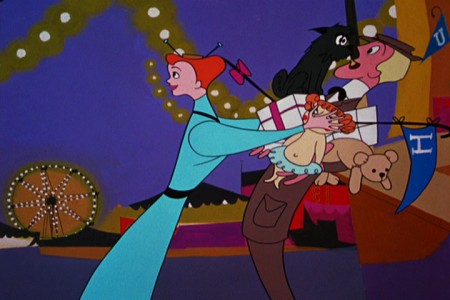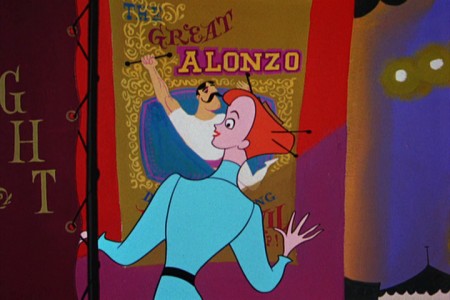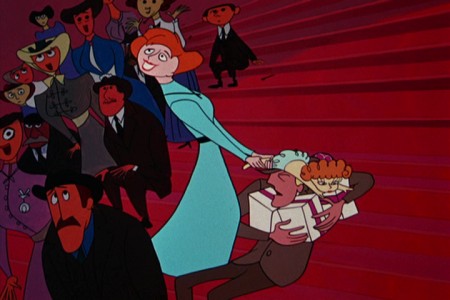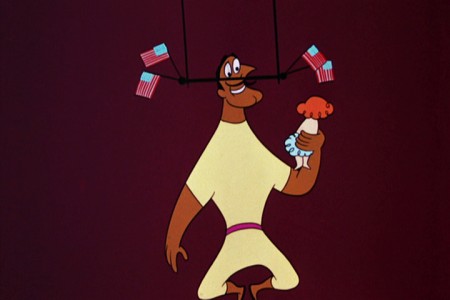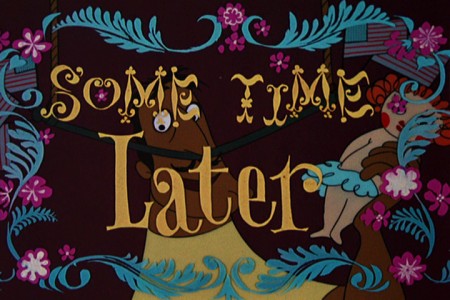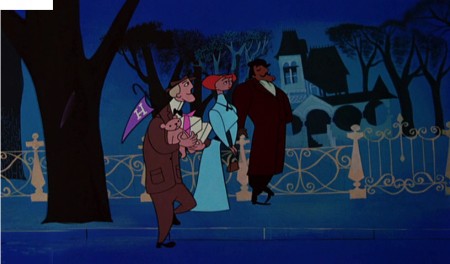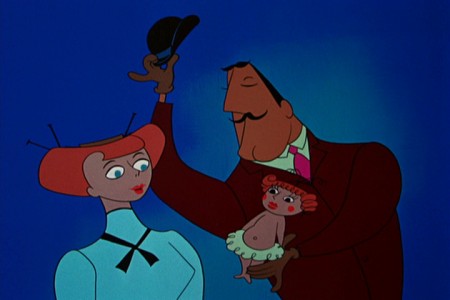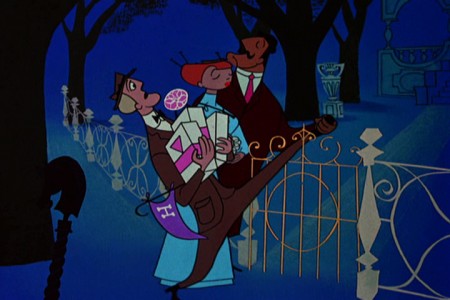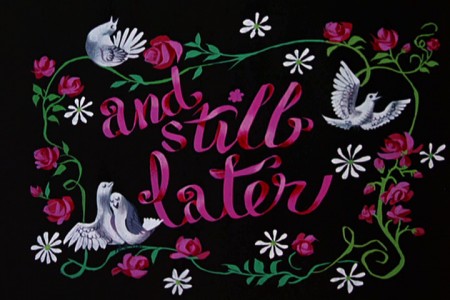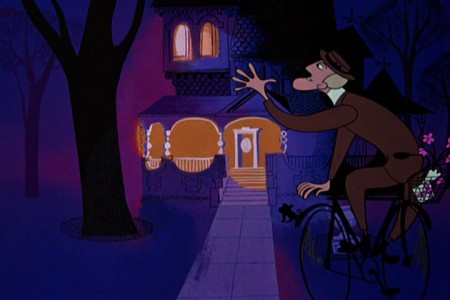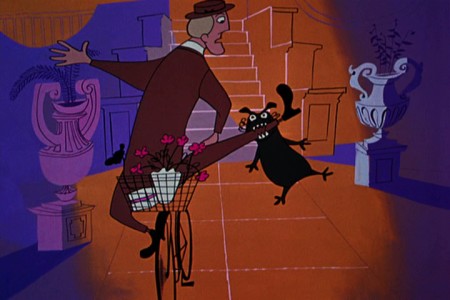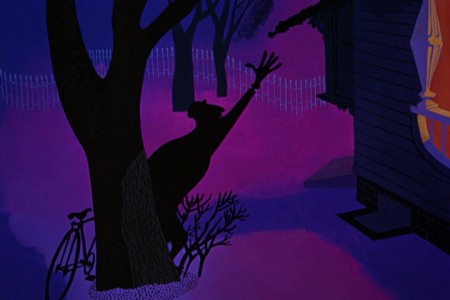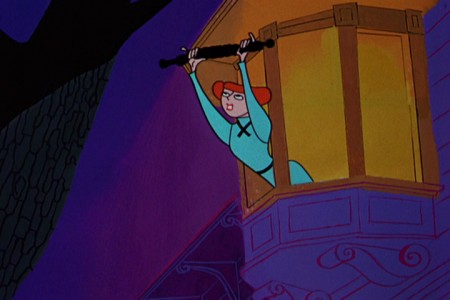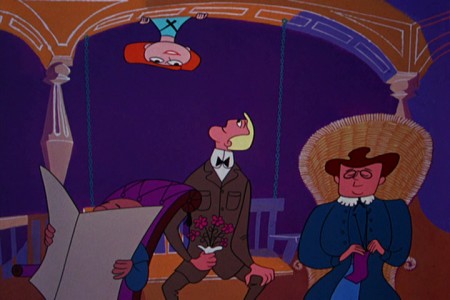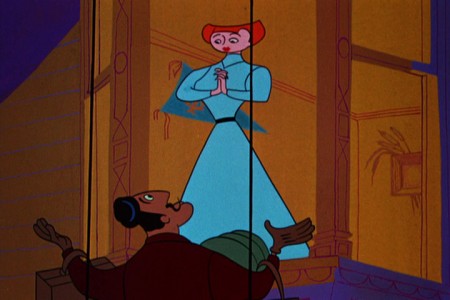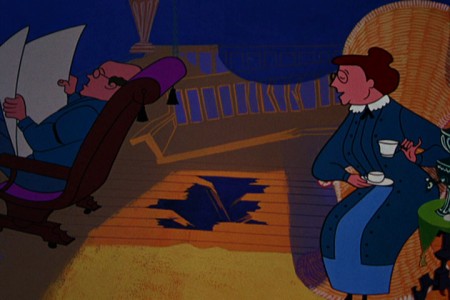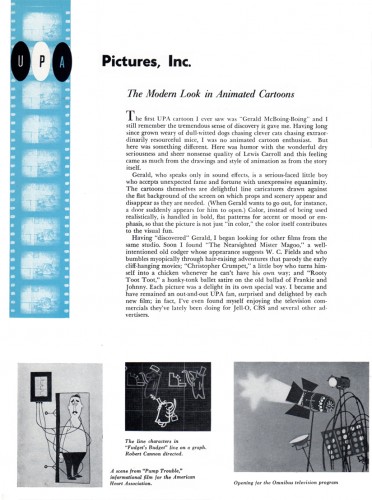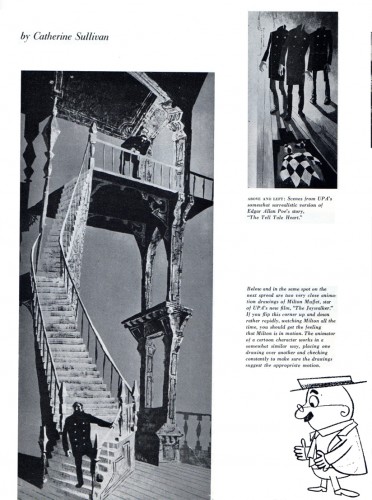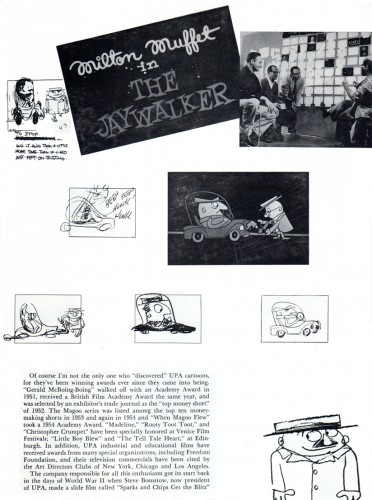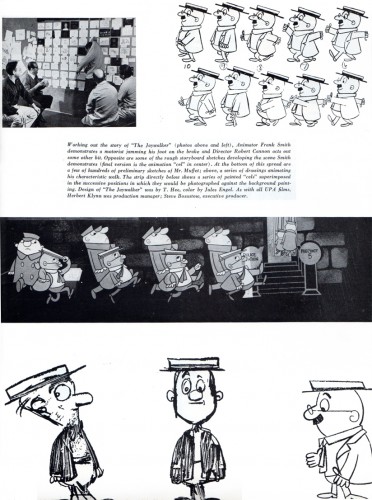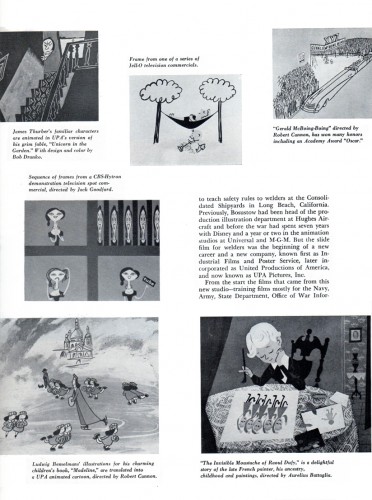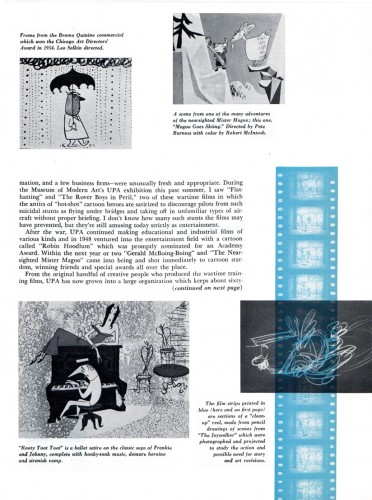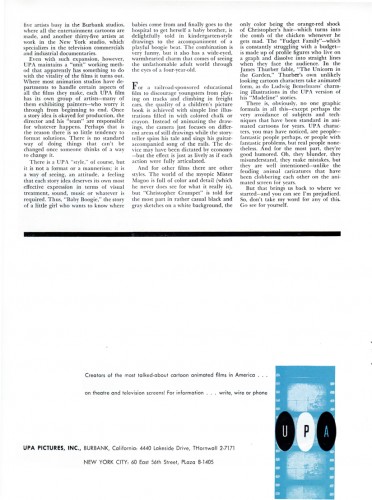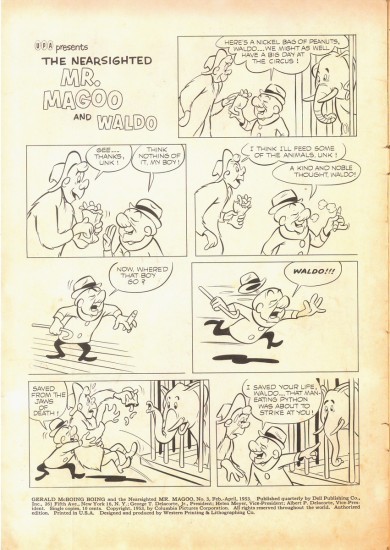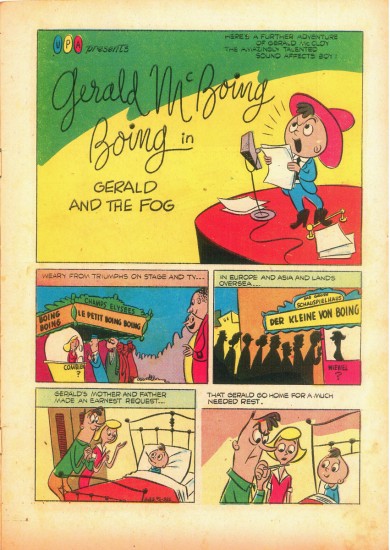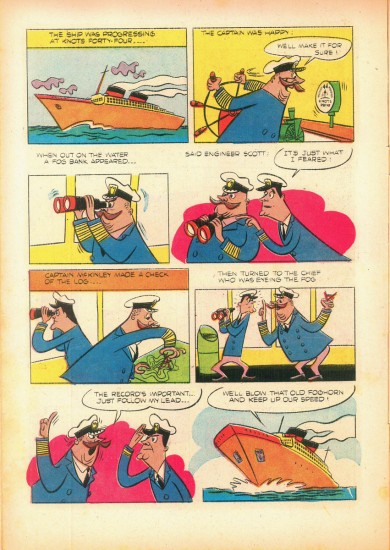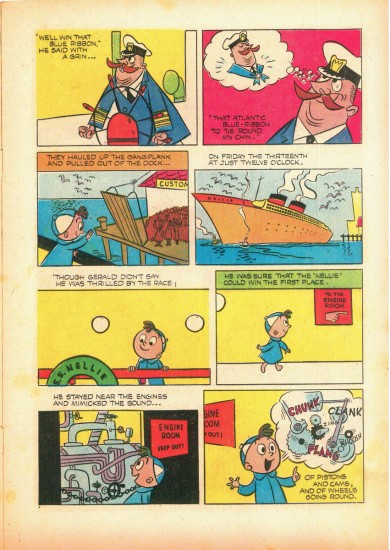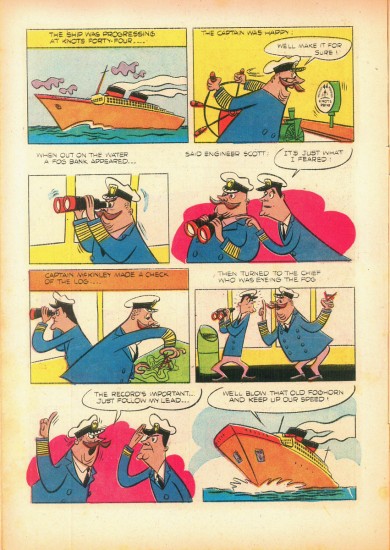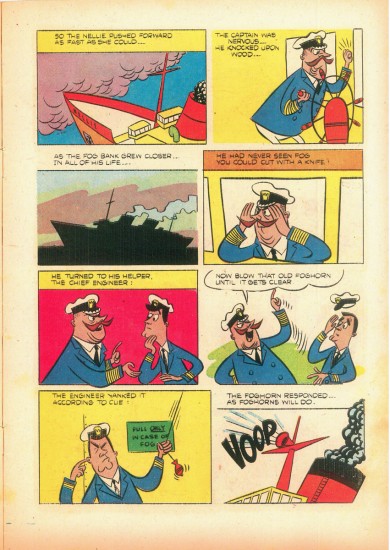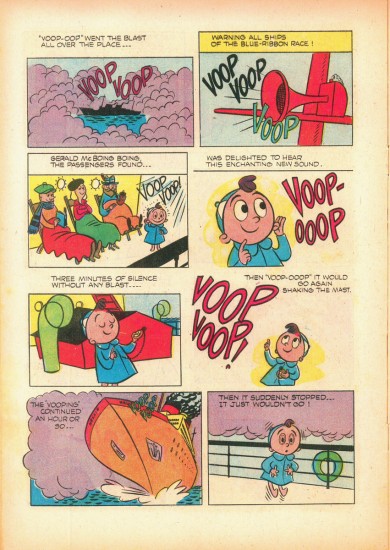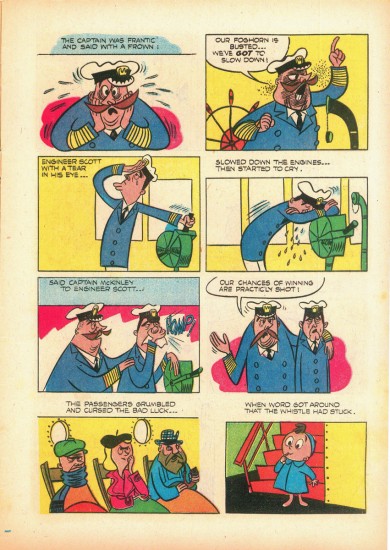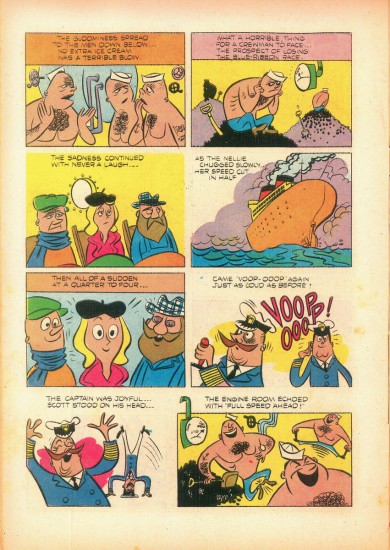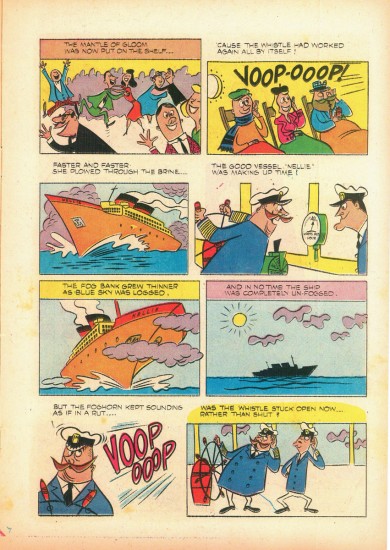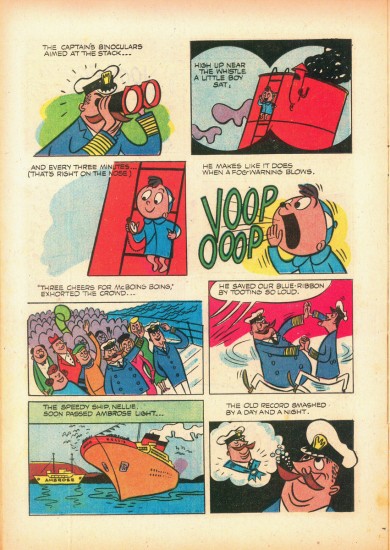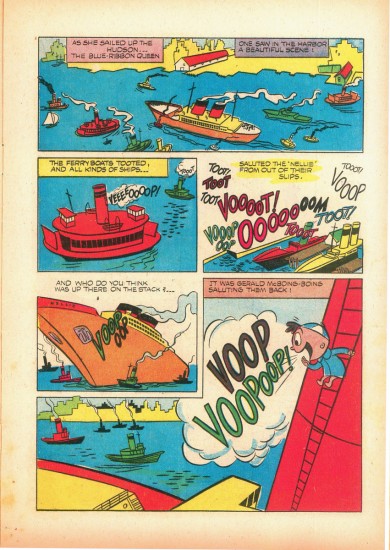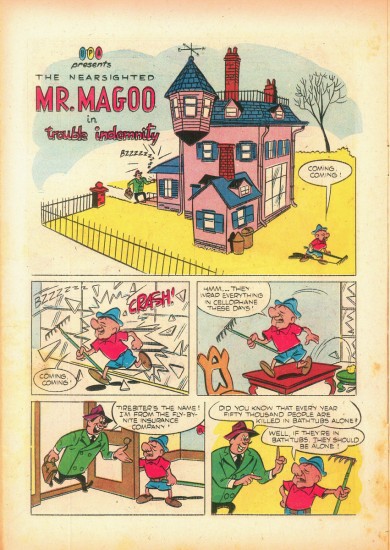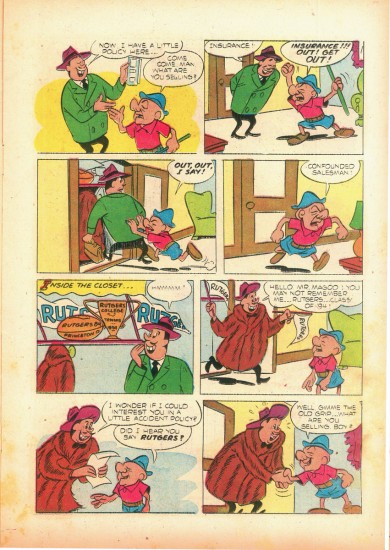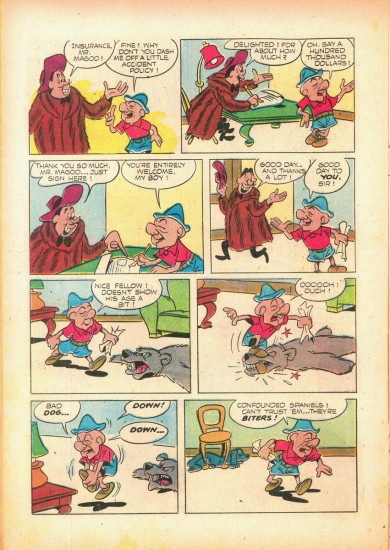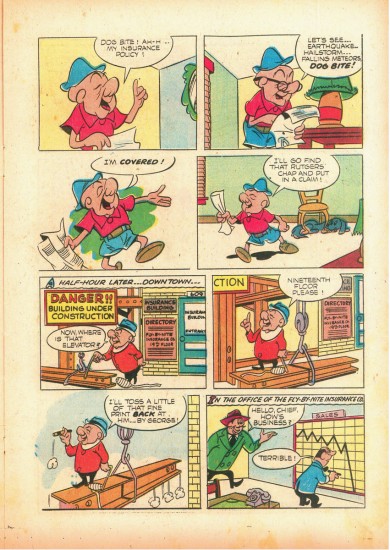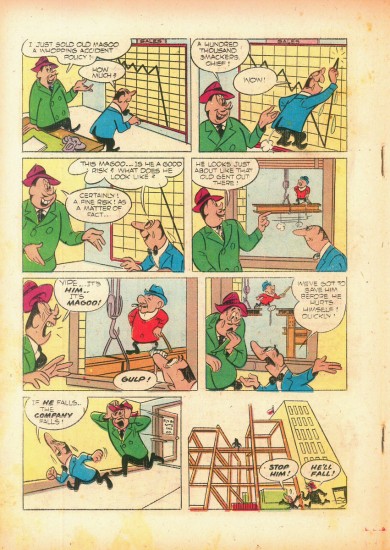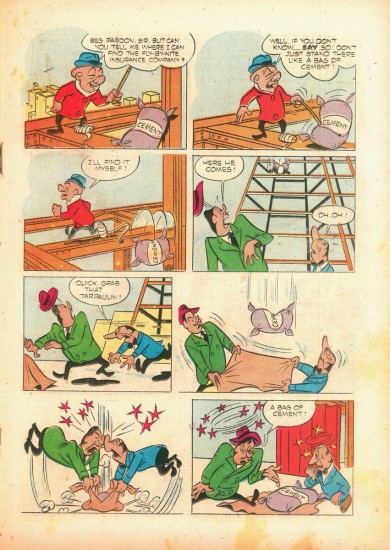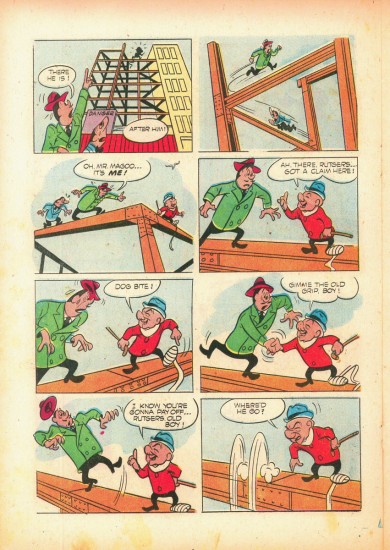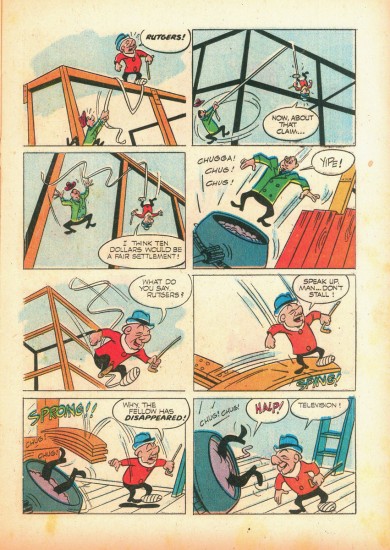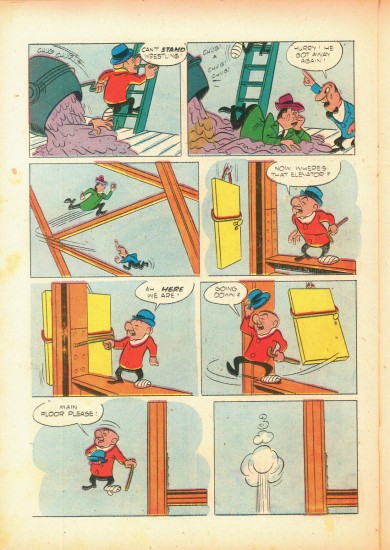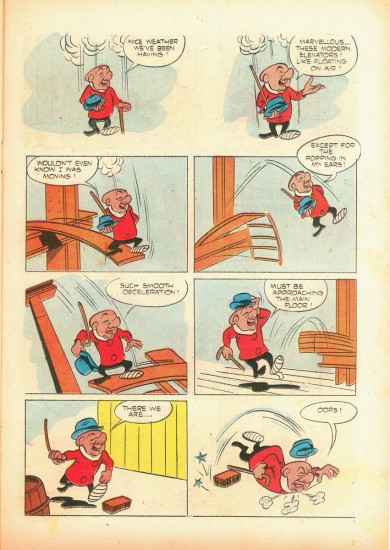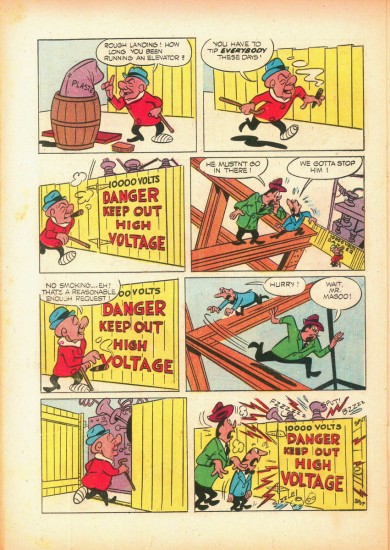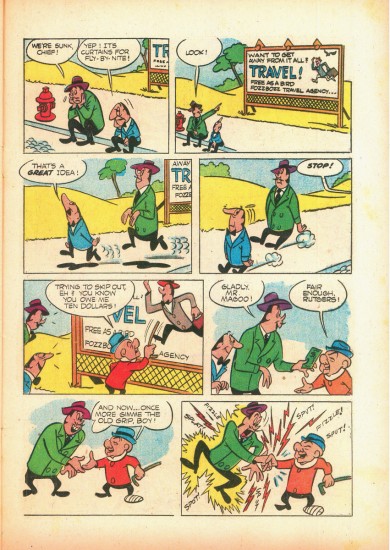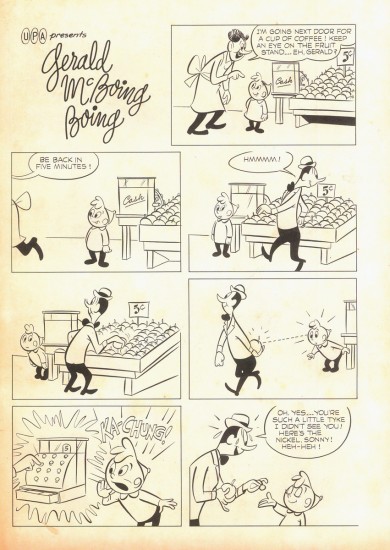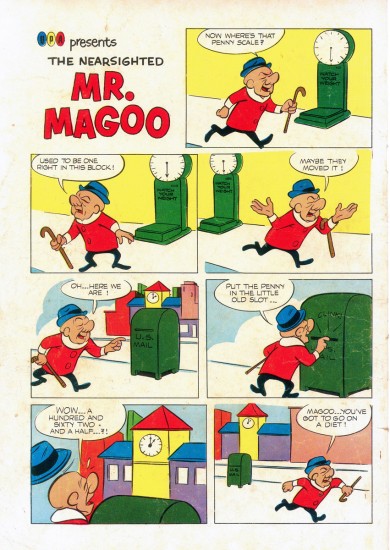Category ArchiveUPA
Animation &Animation Artifacts &Frame Grabs &UPA 22 May 2012 06:55 am
Nelly Bly’s Twisted Arms
This is one of my favorite scenes of all time. Nelly Bly is on the witness stand, and she’s constantly straightening herself out as she gets deeper and deeper into her side of the story. Grim Natwick’s animation is perfect, and John Hubley’s direction and design is even better. The judge, behind her, couldn’t be better positioned.
This is a great cartoon, possibly UPA’s best. It lost the Oscar to The Two Mousketeers, a Tom and Jerry cartoon, and not even a particularly good Tom and Jerry cartoon. It would take another ten years before AMPAS ruled that you had to see the short films to be able to vote on them.
I tried to include this scene with its soundtrack, but it took longer than I could afford to give it.
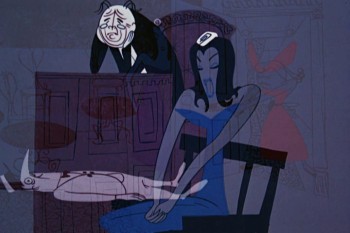 01
01
______________________
The bump in the middle is a hold wherein there’s a
camera move. I replaced it with a short dissolve.
Frame Grabs &Hubley &UPA 21 May 2012 05:15 am
Rooty Toot Toot
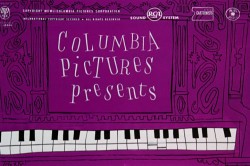 - As you know, I like this cartoon. Rooty Toot Toot. I think it’s one of the very best animated films ever made. The film combines brilliant design, with great animation, and an extraordinary story.
- As you know, I like this cartoon. Rooty Toot Toot. I think it’s one of the very best animated films ever made. The film combines brilliant design, with great animation, and an extraordinary story.
Kurosawa had directed Roshomon in 1950, and it had just touched down in the US. This tells of several people who meet up while waiting out a rain storm as they tell their differing versions of the killing of a samurai. It 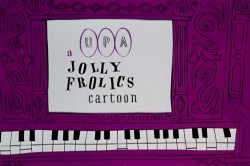 takes place in 12th Century Japan. There is no doubt that Hubley saw this film and does his cartoon adaptation of Frankie & Johnny using the same schema. It was not only daring for animation, but it was daring for film. It took the hands and eyes of a master to pull it off, and Hubley succeeded in the short 8 min cartoon.
takes place in 12th Century Japan. There is no doubt that Hubley saw this film and does his cartoon adaptation of Frankie & Johnny using the same schema. It was not only daring for animation, but it was daring for film. It took the hands and eyes of a master to pull it off, and Hubley succeeded in the short 8 min cartoon.
There is the legend that Steve Bosustow tried to get Hubley to speed up the
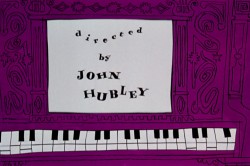 storyboard/writing process where finally the director had to lock himself and the board in to keep the production on hold until he thought it was finished. Eventually, according to the story, Bosustow broke down the door and put the film into its next phase. I don’t know what truth is in this, but I assume there must be a little something to it.
storyboard/writing process where finally the director had to lock himself and the board in to keep the production on hold until he thought it was finished. Eventually, according to the story, Bosustow broke down the door and put the film into its next phase. I don’t know what truth is in this, but I assume there must be a little something to it.
Unlike most other UPA films, this movie was made for an adult audience and it had no
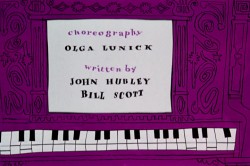 children to speak down to. Unlike most other UPA films, the art style came from 20th century art, not “illustration.” The inspiration was more Steinberg, Ben Shahn and WPA than Vanity Fair or the New Yorker.
children to speak down to. Unlike most other UPA films, the art style came from 20th century art, not “illustration.” The inspiration was more Steinberg, Ben Shahn and WPA than Vanity Fair or the New Yorker.
I’ve decided to pull frame grabs from the film, but that can only account for some still graphics. You really have to see this in motion, and I suggest you watch the version on the TCM Jolly Frolics DVD. It’s the only version that has a good transfer which does the design justice.
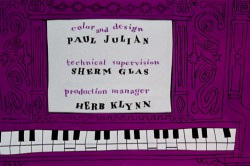
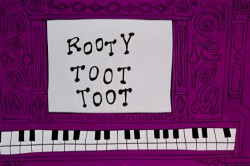
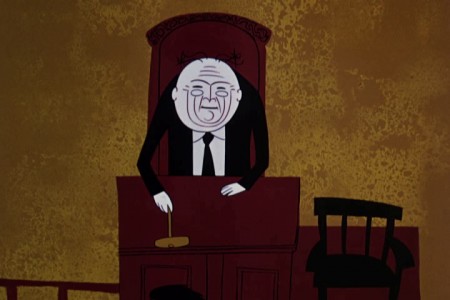 2
2
Gold colors dominate the opening of the trial,
except for Frankie’s bright red dress.

Frankie appears, to stand trial.
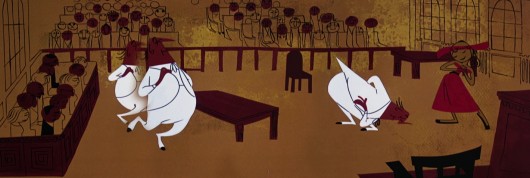
The defense does a dance with Frankie
as he caresses his client.
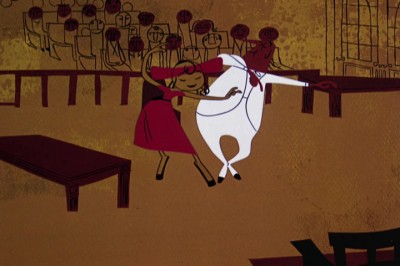 6
6
Choreographer Olga Lunick earned her money on this scene.
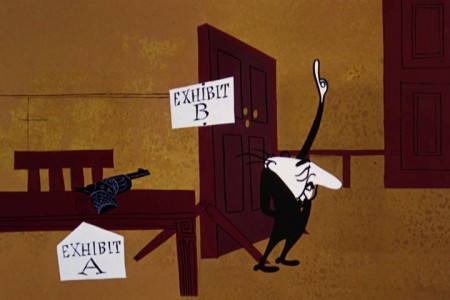 10
10
An open and shut kind of case.

The bartender is the first witness.
He waves hello to half those seated,
before raising his right hand to be sworn in.
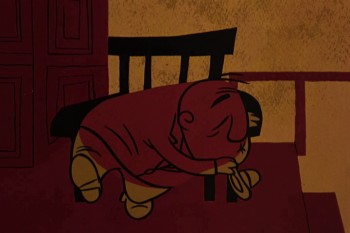 12
12
The bartender brings a subtle color change as
we move from gold hues to brownish colors.
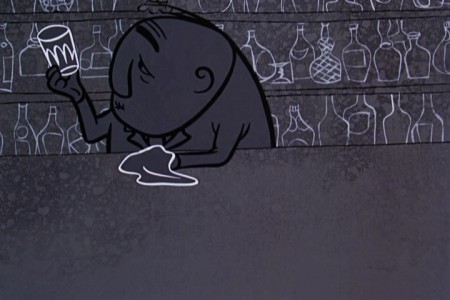 16
16
Once we go back to the bar, bluish grays take the scenes.
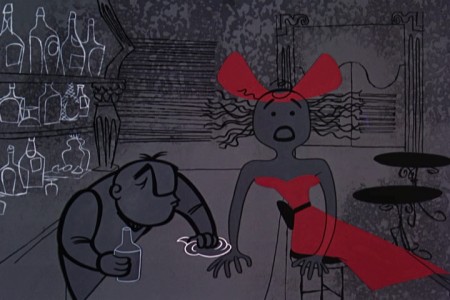 20
20
The bartender revealing Nellie Bly in the back room
foreshadows his reveal at the end of the film.
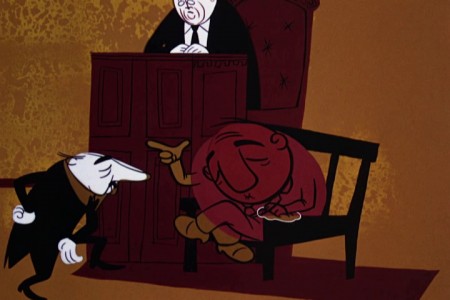 24
24
Back to the browns and ochres in the courtroom.
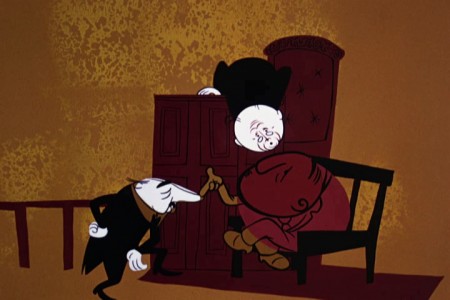 25
25
“Right in the snoot . . . ”
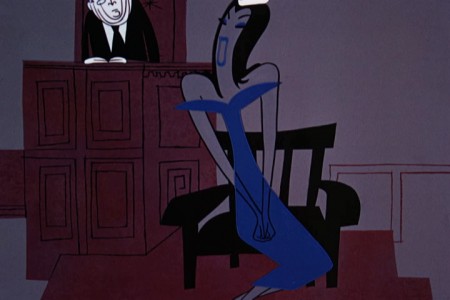 27
27
Nellie Bly brings her violets, lavenders and blues.
The exact opposite of Frankie’s colors.
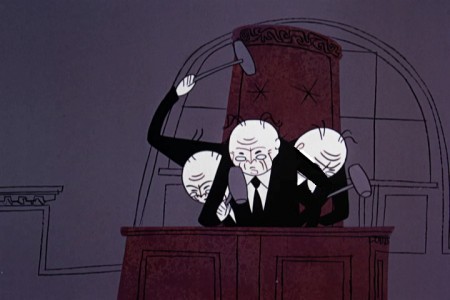 29
29
Order in the court.
The judge doesn’t smear; he breaks into multiple versions
of himself frenetically hammering his desk.
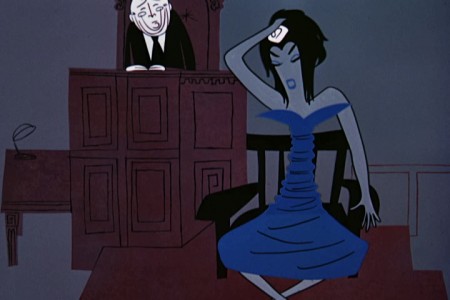 33
33
Straightening out the story . . .
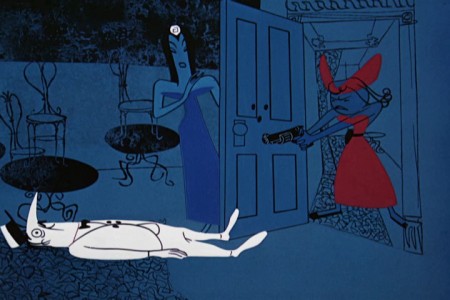 45
45
All blues except for that dress.
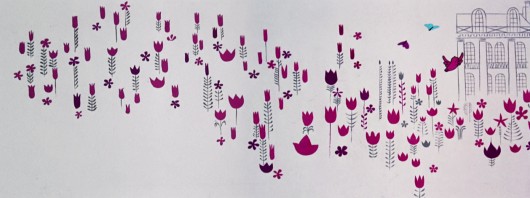
Frankie’s story comes in lily whites and white on white.
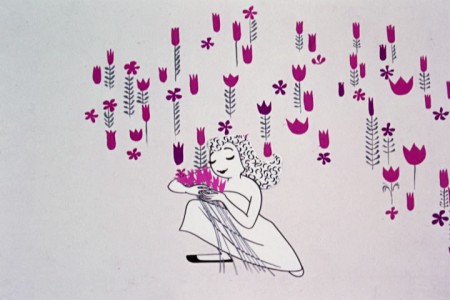 55
55
Her hair in this sequence was matted into the animation.
The decorative pattern didn’t move within the body of the hair.
A real pain in the butt for a design technique. Multiple camera runs.
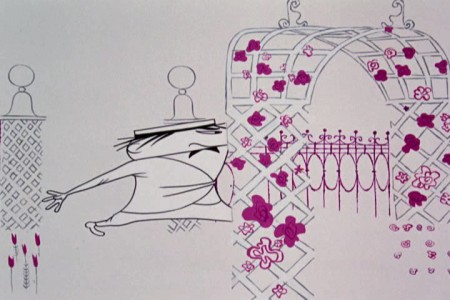 57
57
Smear frames are used in this sequnce for Johnny.
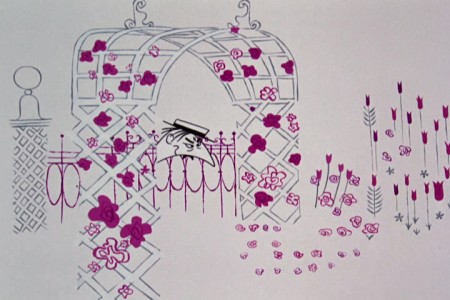 58
58
the victim is made to be the evil one.
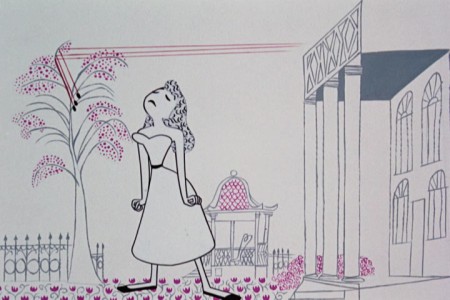 67
67
The bullets ricochet, musically, all over the place.
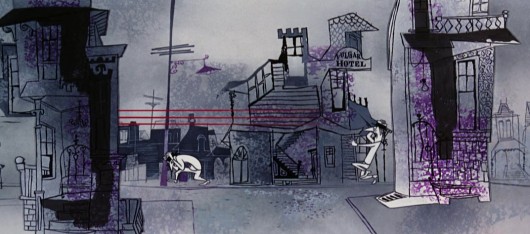
The pure whitish backgrounds turn to dirty grays.
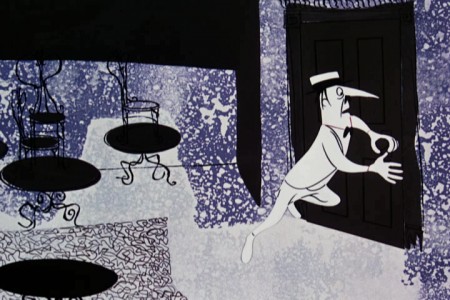 78
78
There’s a reuse of the gag as he looks out the door (see #40 on),
but the animation is different. No expense spared on this film.
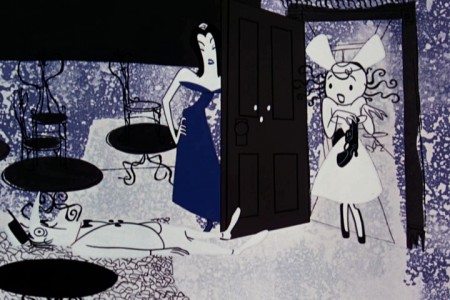 88
88
Back to the courtroom, vermillion is the color dominating.
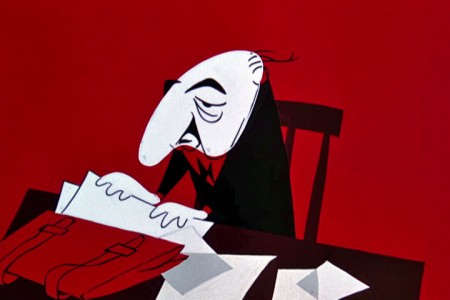 97
97
Back to the courtroom, vermillions turn to
deep reds as the innocent verdict is revealed.
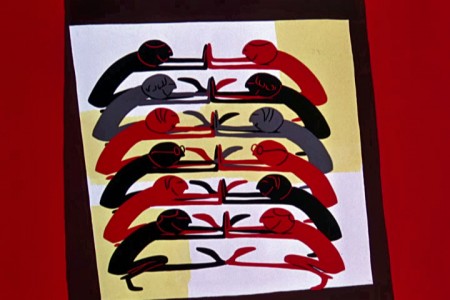 103
103
Very short quick scenes scream at the audience.
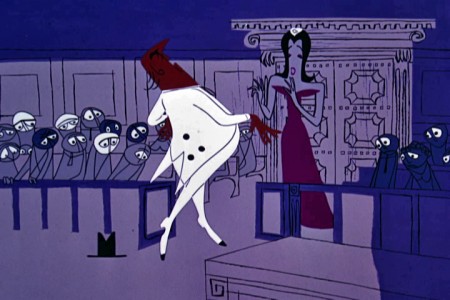 108
108
The attorney’s murder brings bright violets and lavenders.
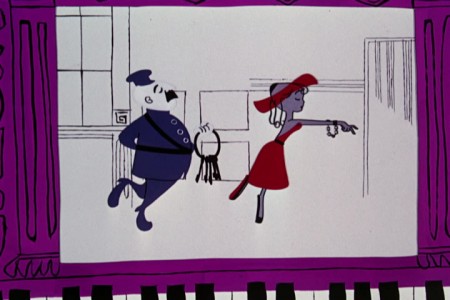 116
116
The lavenders dominate until we pull out
on the purple player piano.
This film, like Nordshtein’s Tale of Tales, is proof that animation can and should be as sophisticated as live action and as adult as any film. This is most certainly one of the classics in animation history. It’s only the animators and producers that hold the medium back.
Frame Grabs &Models &UPA 14 May 2012 05:16 am
Magic Fluke Color Continuity
- The UPA Jolly Frolics DVD set includes a set of extras which showcases a good deal of artwork from the films. For the Fox & the Crow film, The Magic Fluke, there is a color continuity board by Herb Klynn which indicated how the art should be painted for the individual scenes.
This gave me the opportunity of putting the finished film side-by-side with the color continuity boad and find out where they diverge. (The numbered images with a letter attached {e.g. “2a”} are frame grabs from the movie.)
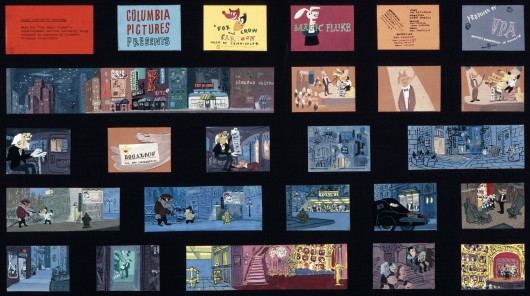
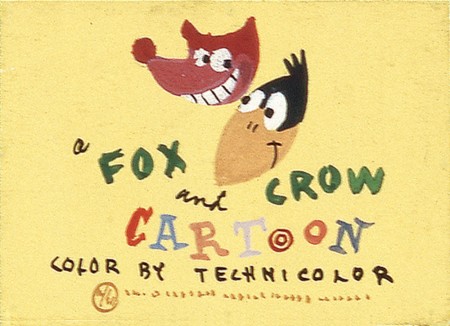 2
2
The differences start with the titles, right from the get go.
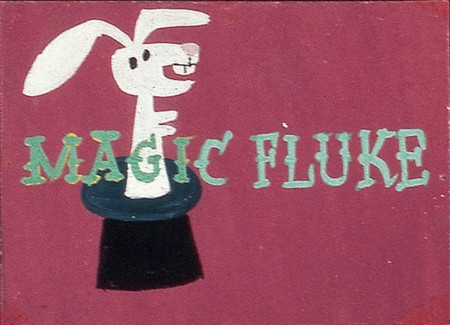 3
3
The color continuity board is much more creative.
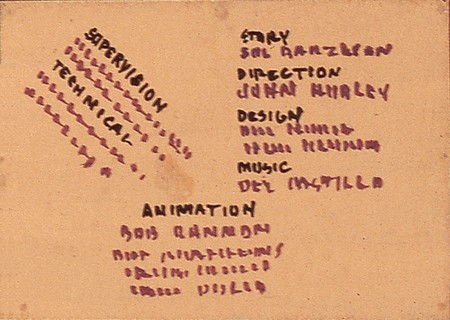 4
4
The final titles are a little dull. Fortunately, UPA’s films got
more creative with their titles once they really got going.

The final BG has the same move and ends with a truck in . . .
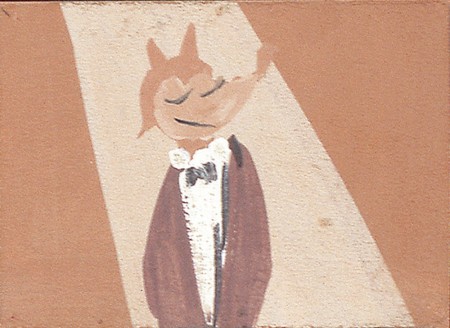 9
9
There’s no close up in there now.
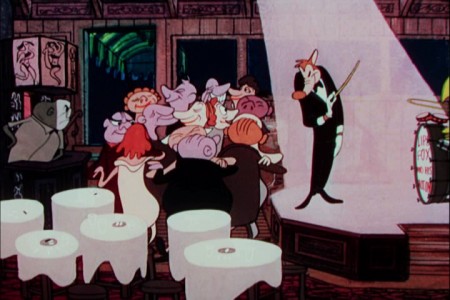 9a
9a
The audience pops from listeners to jazz dancers.
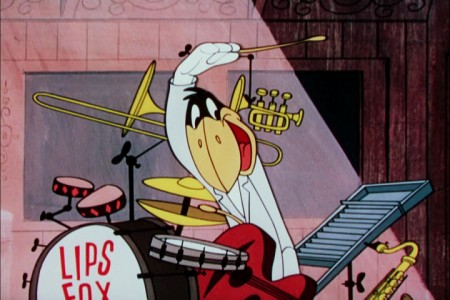 10b
10b
There is a close up of the crow playing wildly.
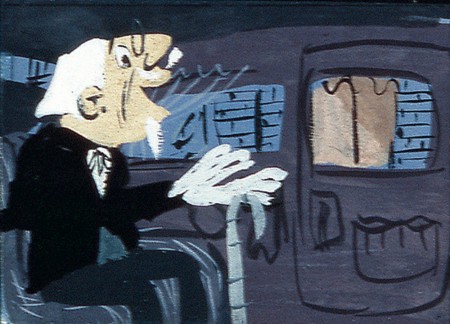 11
11
The impresario is no longer in the film.
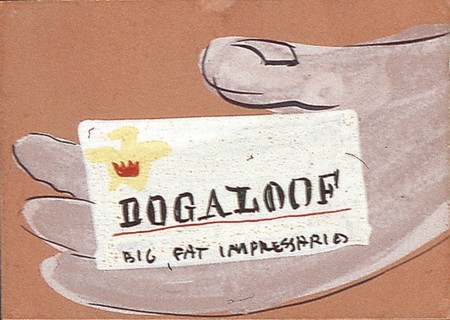 12
12
And he message comes from a taxicab, not a limo.
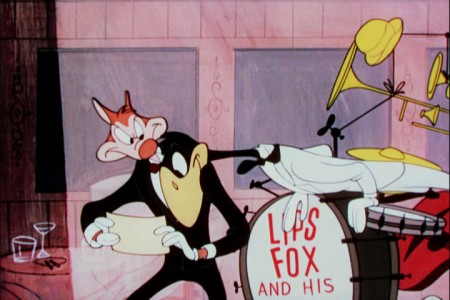 13b
13b
The fox reads the telegram from the stage and hides it from the crow.
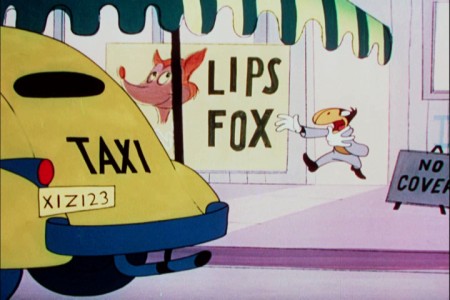 13c
13c
The crow chases the fox out the door as he leaves in a cab.
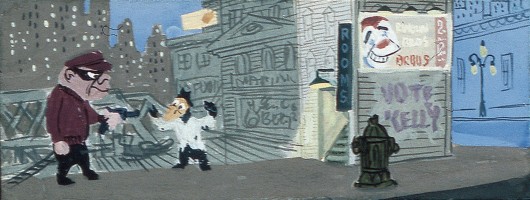
there’s no robbery in the film now. It just rains on a blue street.
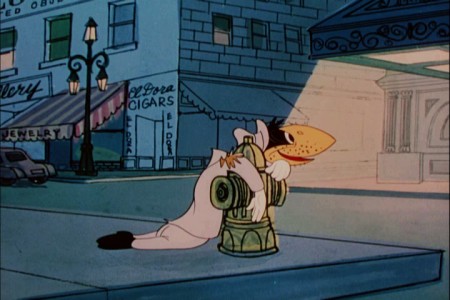 18a
18a
The crow ends up at the spark plug down and out.
He sees . . .
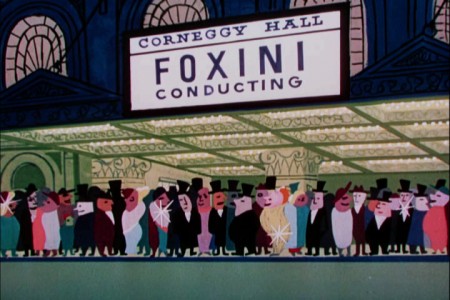 18b
18b
. . . the Foxini ppremiere.
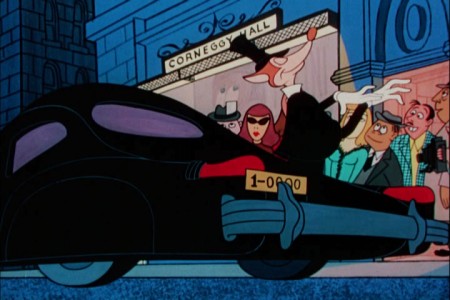 19a
19a
The Fox gets out of the limo.
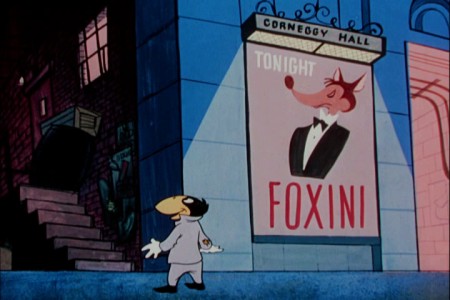 19b
19b
The crow looks up at the backdoor alley.
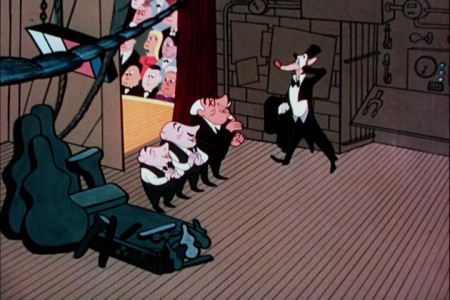 20a
20a
Foxini is greeted by his entourage, and he takes advantage of them.
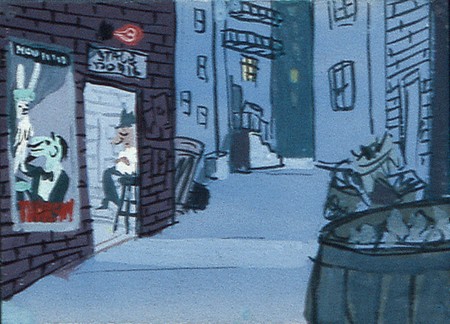 21
21
The back alley is about the same.

We no longer see a pan of the inside of the theater.
 23a
23a
There is a pan up the concert hall.
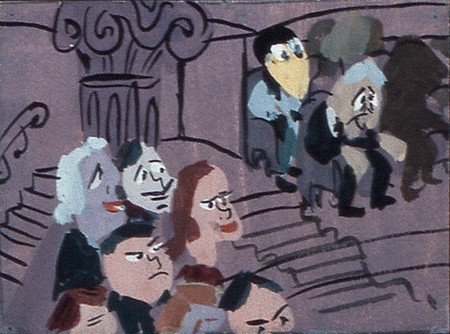 24
24
Crow arrives at the upper upper balcony . . .
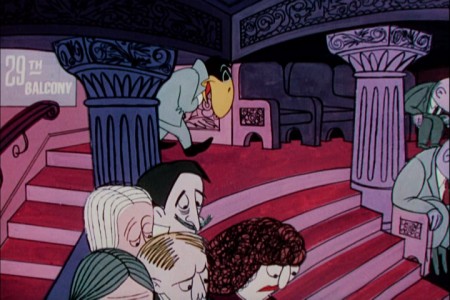 24a
24a
. . . and gets a last row seat.
Unfortunately, they only offered the color continuity board for the first half of the film,
and that’s as far as we could go.
Frame Grabs &UPA 07 May 2012 05:36 am
Julian’s Georgie
- Well, I’m following my fancy. I’m into Paul Julian‘s beautiful painting style, and have found a treasure trove in the UPA collection DVD, Jolly Frolics. Here I have one of the better UPA films, Georgie and the Dragon. It’s a rather simple story, beautifully directed by Bobe Cannon and animated by Rudy Larriva, Bill Melendez, Grim Natwick and Frank Smith. The exceptional script is written by three strong, animation pillars: John Hubley, Bill Scott and Phil Eastman. Paul Julian and Jules Engel seem to have done the backgrounds together.
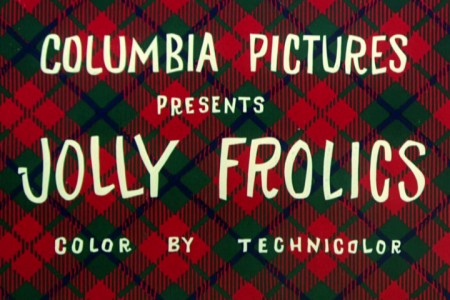 1
1The tartan BG with the yellow type sets up
the Scottish location for the film.
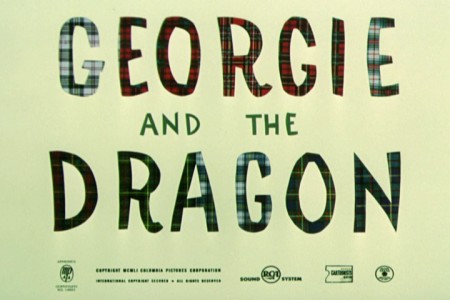 2
2
For the second card they reverse the scheme:
yellow BG with a tartan filled type.

The credits dissolve as the BG pans
and the camera slowly moves in.
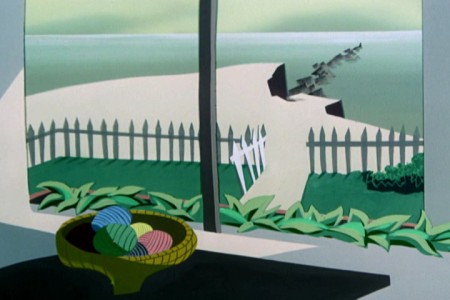 6
6
I think you can distinguish between the Paul Julian Bgs
and the Jules Engel bgs. Julian was more apt to use
drybrush in his work, and it gives it a singular look.
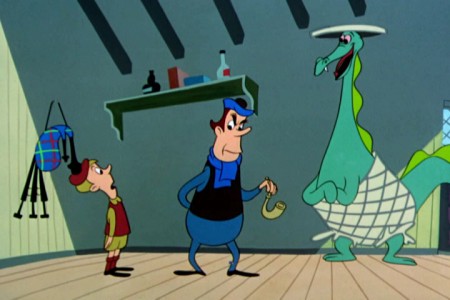 27
27
Just look at these wild poses even though
the characters are at rest.
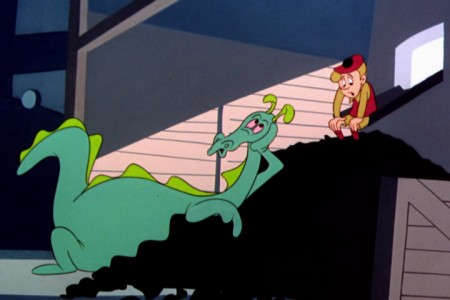 41
41
UPA didn’t just introduce a new kind of design,
it brought a new style of animation that made
that design work.
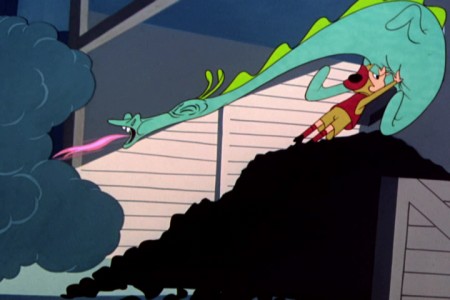 42
42
Bobe Cannon was the perfect animator to direct
the animators in this new looseness and sense of
graphic movement in animation.
Go here to see the comic book adaptation of the cartoon.
I found the following model sheets on Stephen Worth‘s excellent site, AnimationResources.
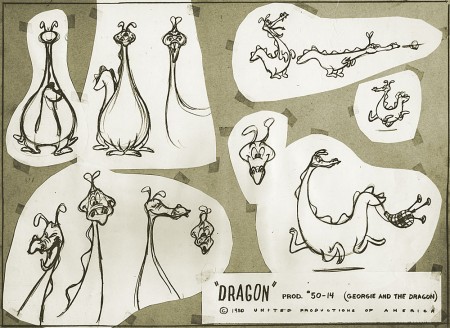
Frame Grabs &UPA 30 Apr 2012 06:14 am
Tell Tale Bgs
- Of all the pleasures I’ve gotten from the recently released UPA dvd Jolly Frolics the Backgrounds of Paul Julian are a particular enjoyment. His most famous and greatest achievement is, of course, the work he did on The Tell Tale Heart. This is his film. Ted Parmelee directed it, but I’m certain that he pretty much set the camera moves and timing, leaving all the design work for Julian.
I’m trying to feature Paul Julian’s work in a number of posts here, so today it’s The Tell Tale Heart.
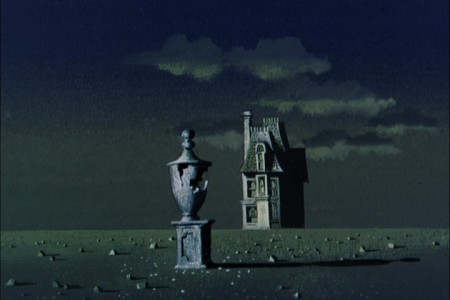 1
1
commercial animation &Layout & Design &UPA 23 Apr 2012 05:15 am
The Man on the Flying Trapeze – pt.2
- Here is the 2nd half of the frame grabs of the UPA film, The Man on the Flying Trapeze. As I said, last week, the film is not the best of UPA. However, Paul Julian’s work, to me, is always sterling, and that’s my reason for putting some focus on the film. Julian did the design and backgrounds.
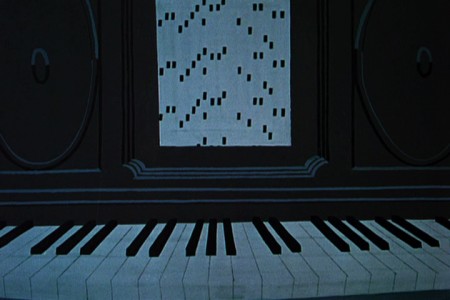 34
34
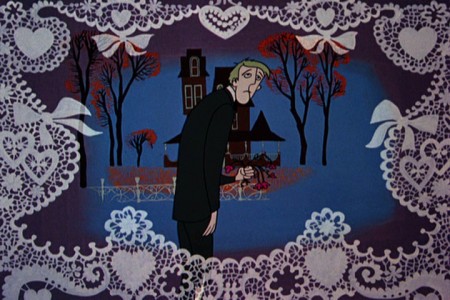 36
36
36-39 is an interesting transition.
The guy walks through all types of weather
as the fleur du lis framing device falls away.
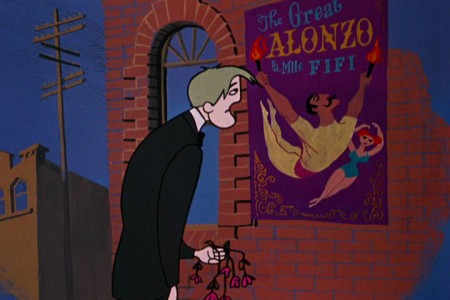 40
40
39 dissolves to 40 and moves in.
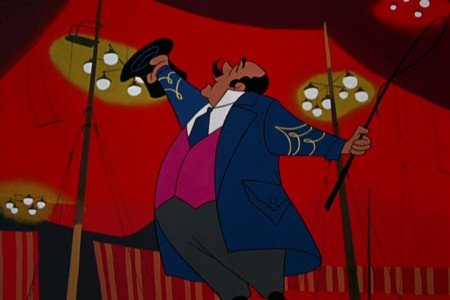 47
47
A beautiful layout and setup.
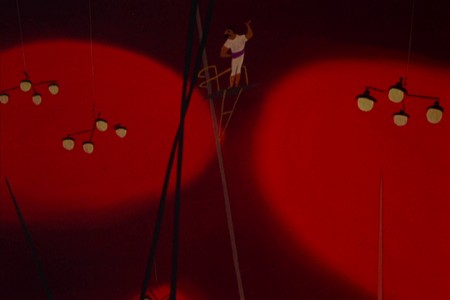 48
48
47-49 pans down while revoving while pulling out.
It was impossible to try to hook up the artwork,
so I left it apart.
 51
51
Start at the bottom and quickly pan up.
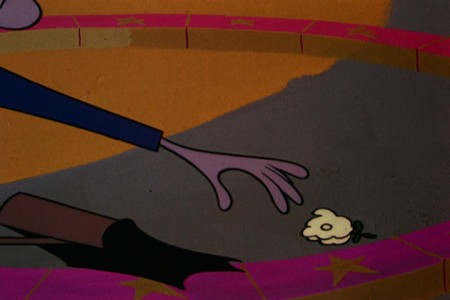 57
57
He reaches for the flower -
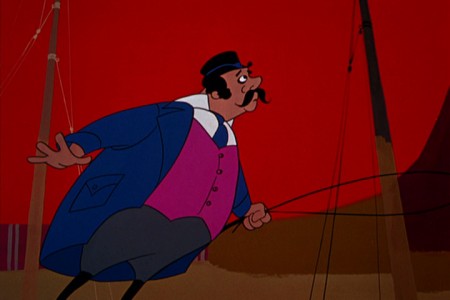 59
59
The ringmaster sees what is happening.

The Trapeze Artist tumbles and twirls and flies to the end of the routine.

He lets go og the cord at the end of the pan.
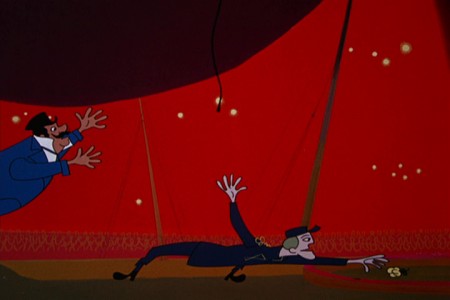 65
65
The ringmaster jumps to get it.
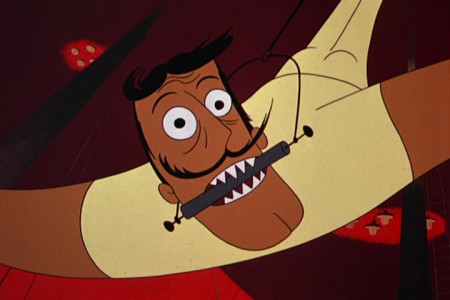 68
68
The end of the Trapeze Artist.
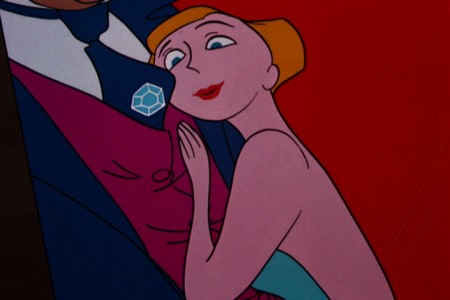 70
70
Diamonds are a girl’s best friend.
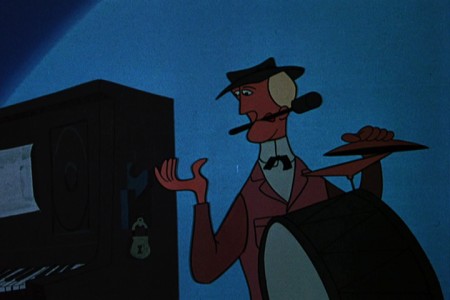 72
72
No more coins to put in the player piano.
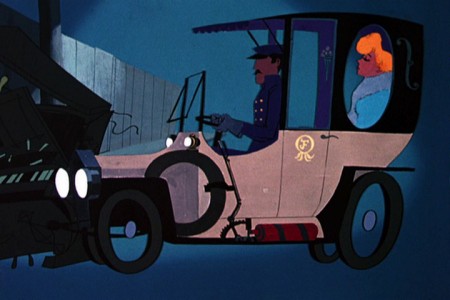 75
75
A car chauffering the girl comes crashing through the piano.
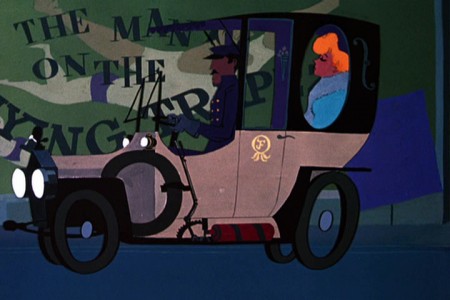 76
76
It passes across the main title card.
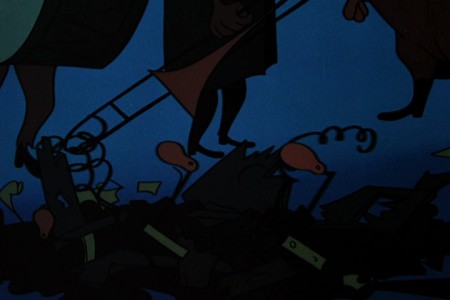 80
80
The last scene should start at the feet and move up
to the full band, beaten. (There’s a hint of a move on
the DVD.) But it cuts off here to the End card.
commercial animation &Layout & Design &UPA 16 Apr 2012 04:59 am
The Man on the Flying Trapeze – pt.1
- The new UPA dvd 3-set comes in three separate categories: there are the Great films, the Good films, and the Bad films. Definitely, one of the Bad films is The Man on the Flying Trapeze. It seems to want to be either The Dover Boys or Rooty Toot Toot, and it’s most certainly neither. The film is just poorly plotted. There are some interesting transitions and some interesting set pieces. I give credit for that to the designer.
The designer is Paul Julian who also did the backgrounds, and his work, as far as I’m concerned, is brilliant. I decided to pull frame grabs of this film to highlight the beautiful design and background work of Julian. It’s taken a very long time, and I’ll have to break this post into two. I just can’t get it all done in one day. But I hope you can see the excellence of Julian’s work.
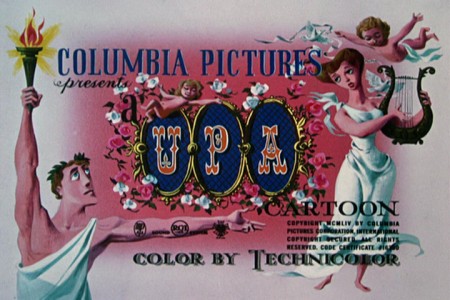 1
1Just a brlliant title card.
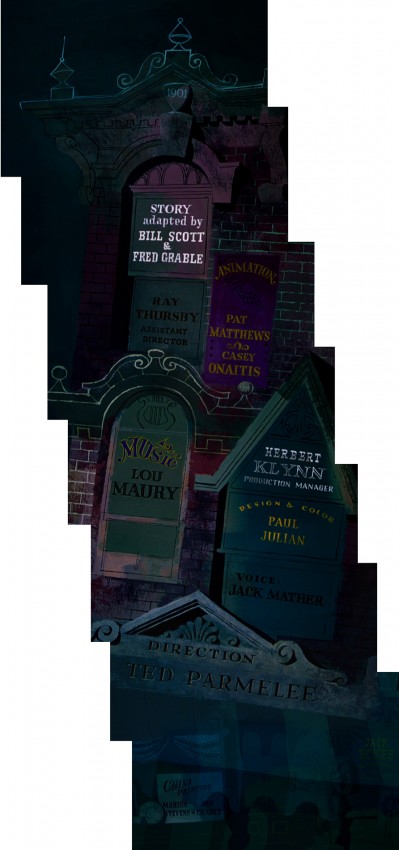 2
2
A slow pan down over the credits.

Left to right stoppng on the main title.
Then continuing into the scene.
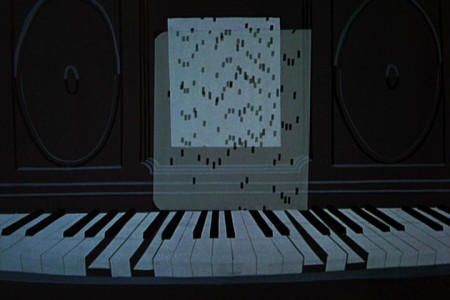 5
5
The player piano sets the mood for the entire film.
A ragtime score, piano leading, with little consequential dialogue.
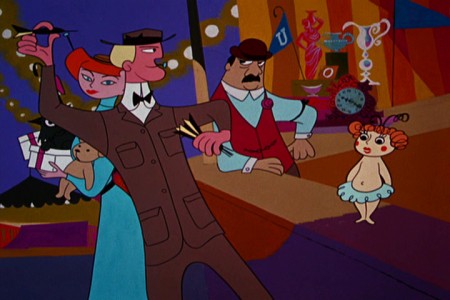 7
7
The guy just fades on, in place, ready to throw the dart.

Pan left to right with the Trapeze Artist.
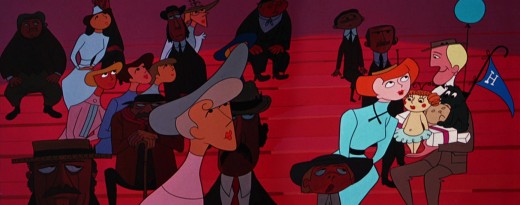
Slow pan left to right with the audience.
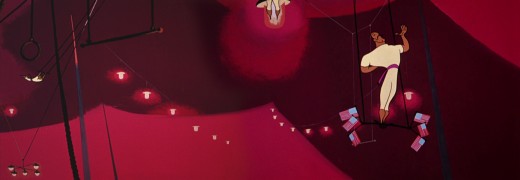
Again pan left to right with the Trapeze Artist.
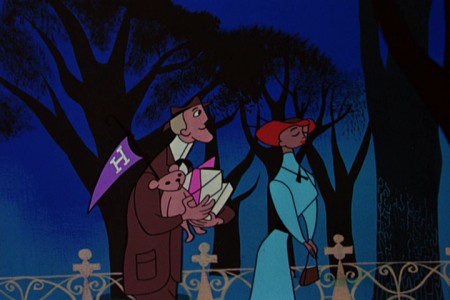 17
17
Beautiful trees remind me of the scene in The Dover Boys
where the villain pulls the heroine away from the tree.
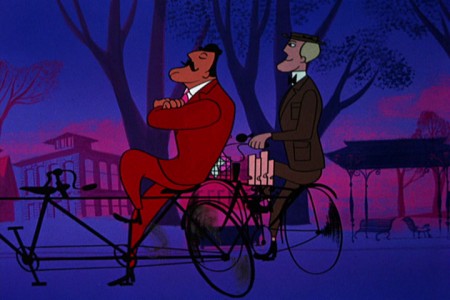 23
23
The man from the trapeze passes our hero . . .
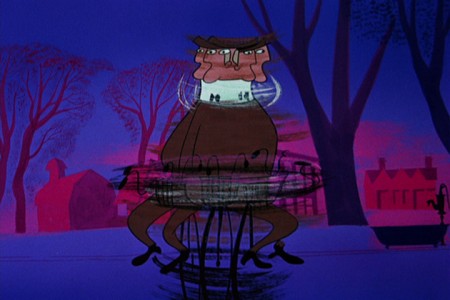 24
24
. . . who spins out of control.
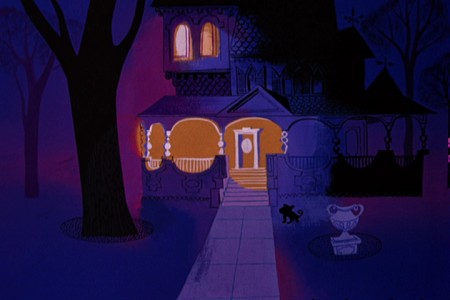 25
25
A beautiful Julian house and a great new color scheme
for this section of the film.
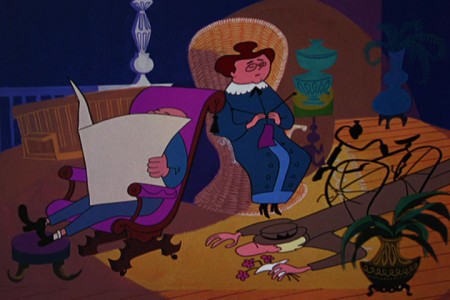 28
28
Taking advantage of the new colors to . . .
to be concluded next week.
Books &Hubley &UPA 07 Apr 2012 07:20 am
When Magoo Flew & Jolly Frolics
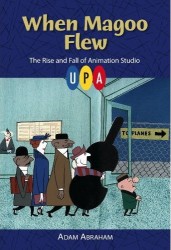 – Adam Abraham‘s new book, When Magoo Flew: the Rise and Fall of Animation Studio UPA, is a gem. It’s an intensely researched and informed book about a studio that has gotten little real attention before this. There have been bits and pieces about specific films and people at the studio, and there’s the extraordinary chapter in Mike Barrier’s Hollywood Cartoons which encapsulates much of the material in this book.
– Adam Abraham‘s new book, When Magoo Flew: the Rise and Fall of Animation Studio UPA, is a gem. It’s an intensely researched and informed book about a studio that has gotten little real attention before this. There have been bits and pieces about specific films and people at the studio, and there’s the extraordinary chapter in Mike Barrier’s Hollywood Cartoons which encapsulates much of the material in this book.
When Magoo Flew starts off in a political mode, and in some way it stays there throughout. Perhaps that’s at the heart of the UPA story. At first, we read about the Disney strike which caused many artists and renegades to leave the Disney studio and strike out for something bigger, freedom to draw in a more modern mode. The book stays with politics as we see the formation of the UPA studio; there’s so much in fighting as partners turn on each other to take control of the studio. Once they’re in the heyday of the studio it’s the politics of who’s doing what. Animosities played a large part. When John Hubley didn’t like the painting of Herb Klynn, (“I cannot stand another touch of that Klynn green!”) he brings the brilliant painter, Paul Julian, into the studio. When Jack Heiter refused to listen to Jules Engel‘s demand to change to color ofthe sky in a background, Heiter was fired. Eventually we move to the politics of the HUAC hearings and the McCarthy era anti-Communist attacks on Hollywood. Finally, it gets down to the politics of selling and reselling the studio and the archives.
It’s a compelling story.
Within this book of politics, we see every film develop and succeed or fail. From Hell Bent for Election to Ragtime Bear (and Mr. Magoo) to Gerald McBoing Boing to Rooty Toot Toot. We see the careers of John Hubley, Bobe Cannon, Pete Burness, and many others develop and grow. All the info is in there: the history of the key shorts as well as the many feature attempts amd the two completed, as well as the mini-bios of all the people. It’s one of those books where you trust the facts and are sure the author did the homework. (The only quibble I had was in his saying that Hubley had one “big” shot at a feature with Watership Down, when in fact Hubley produced and directed two features of his own within his studio, although maybe Abraham didn’t mention them because they weren’t “big”.)
This is what I consider to be an important book in my collection, and I’d encourage everyone interested in animation history to get a copy if they can. At least, get yourself to a library to read it. I’d also like to suggest that you check out Mike Barrier‘s comments about the films of UPA in his review of the DVD. He links to the chapter in his book about the history of the films.
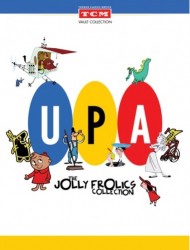 There’s also a companion piece – a DVD that was released by Turner Classic Movies, and it, too, is a treasure. Jolly Frolics, the UPA Collection contains beautifully reconstructed copies of many of the one-off films, the Jolly Frolics. These, for the most part, were the non-Magoo shorts. (There will be an all Magoo release this coming June.) Many were directed by Bobe Cannon, but there are plenty of othrs by Hubley, Babbitt, and Burness as well. (I ceertainly plan to use this DVD to really go into the films and comment on some of them in the future. There’s too much wealth here for me to pass by.)
There’s also a companion piece – a DVD that was released by Turner Classic Movies, and it, too, is a treasure. Jolly Frolics, the UPA Collection contains beautifully reconstructed copies of many of the one-off films, the Jolly Frolics. These, for the most part, were the non-Magoo shorts. (There will be an all Magoo release this coming June.) Many were directed by Bobe Cannon, but there are plenty of othrs by Hubley, Babbitt, and Burness as well. (I ceertainly plan to use this DVD to really go into the films and comment on some of them in the future. There’s too much wealth here for me to pass by.)
The brilliance of Rooty Toot Toot or Gerald McBoing Boing or The Tell Tale Heart stands out against many of the others which here seem even more ordinary. The Man on the Flying Trapeze or Baby Boogie or Giddyap prove that not all UPA films are gems. Like any other cartoon studio’s product, there were good, bad and, mostly, mediocre films.
However, this collection are all marvelously brought back to their original life with this release, and TCM has to be applauded for this first collection of cartoons among their releases. The extras on the DVD includes commentary tracks by Jerry Beck and Leonard Maltin. These are worthless, as far as I’m concerned. Half of their comments involve complimenting the newly found colors of the DVD copies. Neither seems to know more than the basics about UPA. After the first commentary track, they’re all the same. With this DVD, you’re buying them for the fantastic originals on display.
When I was 11 The Gerald McBoing Boing Show premiered on CBS. Anything to do with animation meant it was playing on my family’s TV set. Ohere than these cartoons, everything anmated on TV meant the old B&W WB cartoons featuring the fat Porky Pig. There were early B&W Terrytoons as well, and even some Aesop’s Follies (silent cartoons with classical music tracks added) running on ABS. Of course, there were the special Disneyland TV shows which ran not often enough for my taste.) But the UPA cartoons were different. They looked different, they moved differently, and they struck my young eyes as important. I became an instant fan. I’ve waited for this book and DVD most of my life. It was worth the wait.
Animation &Articles on Animation &Bill Peckmann &Books &UPA 22 Mar 2012 08:29 am
UPA brochure
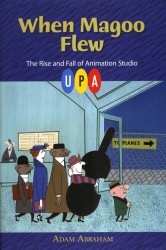
- Given the current release of the Jolly Frolics DVD that has just been released via TCM, and given the release of the new book by UPA book When Magoo Flew, by Adam Abraham, I thought this a good time to repost this brochure which seems to tie into the exhibit at the MoMA.
- Bill Peckmann sent me this brochure back in 2011. I’d not seen it before he’d sent it, so became a bit of a treasure to me, a big fan of UPA.
Here’s Bill’s note:
- This is a studio brochure/mailer* reprinted from American Artist Magazine Nov. 1955. I remember reading the article in high school, it had a huge impact. I remembered it for many years after because of the scarcity of animation articles at that time. And, because it appeared in an “art” magazine, it seemed to make “cartooning” legit.
Did Disney art ever appear in an “art” magazine around this time?
*This brochure was given to me by Ruth Mane (UPA Alumni) many, years ago.
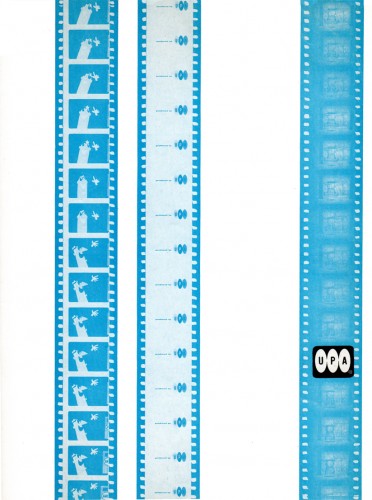 1
1(Click any image to enlarge.)
There’s no doubt this article followed up on the Museum of Modern Art‘s 1955 show of UPA art. Amid Amidi posted an extraordinary piece about this show on his Cartoon Modern site. By the way, this is an exquisite site. It’s just a shame that Amid let it lay after his promotion for his book Cartoon Modern. Take some time and browse around that site when you have some time.
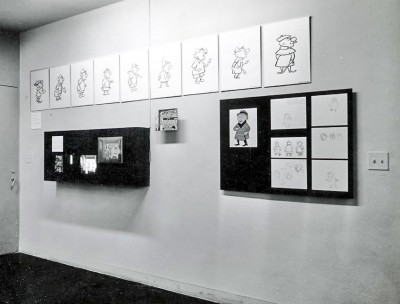
A snap of one of the walls at the 1955 MoMA UPA Exhibit.
(from Amid Amidi’s site, Cartoon Modern.)
Comic Art &UPA 20 Mar 2012 09:21 am
McBoing Magoo Comic Book
- Since I’m well into the book, When Magoo Flew by Adam Abraham I thought it an appropriate time to take a look at this comic book I have. From 1953, it’s a Gerald McBoing Boing / Mr. Magoo mash up, a Dell comic book. The artwork is wildly off model from the animated cartoons and is wild enough to look like a Jim Tyer impersonator trying to do 20th Century graphics, just the way UPA would do them.
I don’t know who the artists were, and wonder if anyone out there has a clue. Please to leave a comment if you can figure it out. Here are two of the three stories in the magazine – one McBoing Boing and one Magoo.
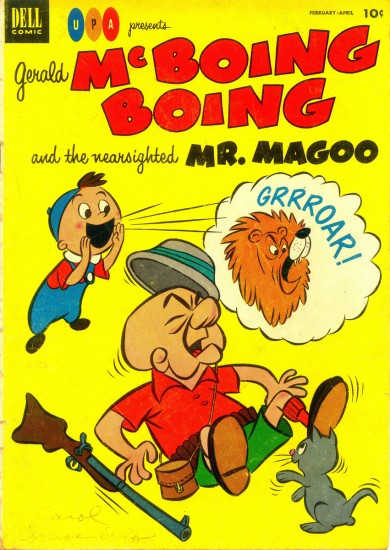
The comic book cover
